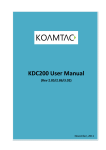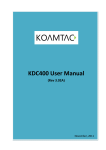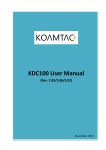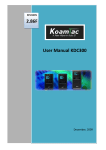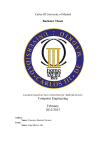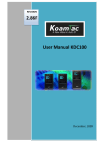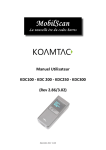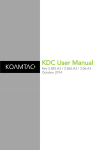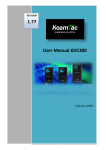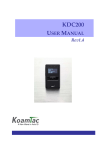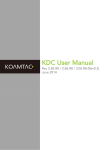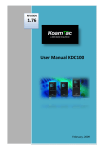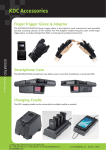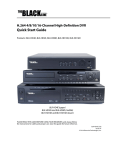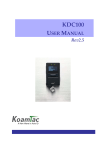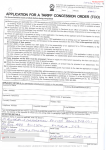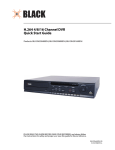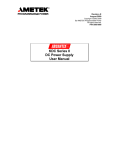Download KDC300 User Manual
Transcript
KDC300 User Manual (Rev 2.85/2.86/3.02) November, 2011 KDC300 User Manual TABLE OF CONTENTS LISTING OF FIGURES............................................................................................................... 6 LISTING OF TABLES ................................................................................................................ 7 1. INTRODUCTION ........................................................................................................ 9 1.1 KDC Package ......................................................................................................... 10 1.2 KDC Characteristics .............................................................................................. 11 2. Installation .............................................................................................................. 13 2.1 KoamTac Installation Wizard................................................................................. 13 Windows XP .............................................................................................................. 13 Vista and Windows 7 ................................................................................................ 18 Windows Mobile 5.0+ ................................................................................................ 21 Android ..................................................................................................................... 23 Blackberry ................................................................................................................ 23 iPad/iPhone/iPod touch ............................................................................................. 23 2.2 Manual Installation ................................................................................................ 24 Windows XP, Vista, and 7 ......................................................................................... 24 Windows Mobile 5.0+ ................................................................................................ 24 3. OPERATING THE KDC .............................................................................................. 25 3.1 Getting Started ...................................................................................................... 25 Attach Lanyard to KDC ............................................................................................. 25 Charge KDC Battery ................................................................................................. 25 Configure KDC .......................................................................................................... 26 3.2 Basics..................................................................................................................... 27 Reading Barcodes .................................................................................................... 27 Synchronizing Barcode Data to PC .......................................................................... 27 3.3 KDC Menus ............................................................................................................. 28 KDC Mode Menu ....................................................................................................... 34 View Data Menu........................................................................................................ 34 Set Barcodes Menu .................................................................................................. 34 Code Options Menu .................................................................................................. 34 Scan Options Menu................................................................................................... 34 Partial Display: Allows you to display partial data. User defines the start position and number of characters to be displayed. .................................................................... 36 Data Process Menu................................................................................................... 36 BT Service - KDC200/250/300/400 ............................................................................ 40 GPS Config - KDC250 ................................................................................................ 40 System Menu ............................................................................................................ 40 3.4 LED Status ............................................................................................................. 42 2 KDC300 User Manual KDC100/200/250/300 ................................................................................................. 42 KDC400 ..................................................................................................................... 42 3.5 Empty Battery ........................................................................................................ 42 3.6 Buffer Full ............................................................................................................... 42 3.7 Reset Feature ........................................................................................................ 43 3.8 Replace Battery ..................................................................................................... 44 4. BLUETOOTH - KDC200/250/300/400 ........................................................................ 45 4.1 ConnectDevice ........................................................................................................ 45 4.2 Auto Connect ......................................................................................................... 45 4.3 Auto Power On ........................................................................................................ 45 4.4 Auto Power Off ....................................................................................................... 46 4.5 Beep Warning.......................................................................................................... 46 4.6 PWR OFF Time ........................................................................................................ 46 4.7 PowerOFF Msg ........................................................................................................ 46 4.8 MAC Address .......................................................................................................... 46 4.9 FW Version .............................................................................................................. 46 4.10 Wakeup Nulls ........................................................................................................ 47 4.11 Autolock Time ...................................................................................................... 47 4.12 HID Keyboard ........................................................................................................ 47 4.13 HID Initial and Inter-Character Delay.................................................................... 47 4.14 Control character transmission in HID mode ...................................................... 47 4.15 Function key transmission in HID mode .............................................................. 48 4.16 Disconnect/Reconnect/HID Toggle ...................................................................... 48 4.17 Power .................................................................................................................... 49 4.18 Pairing ................................................................................................................... 49 4.19 Discovering ........................................................................................................... 49 4.20 Connect To ........................................................................................................... 50 4.21 HID Sync ............................................................................................................... 50 5. SYNCHRONIZATION................................................................................................. 51 5.1 KTSync Menu ......................................................................................................... 51 5.2 File Menu ................................................................................................................ 54 Connect to KDC ........................................................................................................ 54 Synchronize .............................................................................................................. 54 Bluetooth .................................................................................................................. 55 5.3 Synchronization Settings ....................................................................................... 56 Destination of Data................................................................................................... 56 Synchronization Methods ......................................................................................... 57 Current KDC Wedge Method ..................................................................................... 58 Synchronization Options .......................................................................................... 59 Application Options .................................................................................................. 59 3 KDC300 User Manual 5.4 Barcode & KDC Settings ........................................................................................ 60 Select Symbologies and Symbology Options ........................................................... 61 Data Editing Option .................................................................................................. 61 5.5 Others Settings ...................................................................................................... 62 5.6 KDC Menu (KDC400) .............................................................................................. 63 5.7 Mobile pKTSync ..................................................................................................... 64 5.7 Mobile pKTSync ..................................................................................................... 64 5.8 Android aKTSync ................................................................................................... 65 KDC and Android Pairing .......................................................................................... 65 Launch KTSync......................................................................................................... 65 5.9 iPad/iPhone/iPod touch KTSync ............................................................................. 67 KDC200i/300i and iPhone/iPad/iPod touch connection instructions ....................... 67 Pair and connect KDC200i/300i and iOS4.0+ in HID mode ...................................... 67 How to disconnect and reconnect HID mode using Up and Down Button keys. .... 68 KDC200i/300i connection using iPhone mode ......................................................... 68 How to connect and reconnect iPhone mode using UP keys. ................................. 69 5.10 Blackberry bKTSync ............................................................................................ 70 5.11 KTSync for Mac OS X ........................................................................................... 72 6. APPLICATION GENERATION .................................................................................... 75 6.1 Application Generation .......................................................................................... 76 Generate Application ............................................................................................... 76 Data Filter Settings .................................................................................................. 77 Application Download and Execution ...................................................................... 79 6.2 Predefined Applications ......................................................................................... 80 Master/Slave ............................................................................................................. 80 Pick/Bin ..................................................................................................................... 82 DB Lookup Application ............................................................................................. 84 Inventory Application ............................................................................................... 86 7. TROUBLESHOOTING ................................................................................................ 87 8. WARRANTY .............................................................................................................. 88 9. CONTACT INFORMATION ........................................................................................ 89 APPENDIX A - BARCODE & SCAN OPTIONS ................................................................ 90 A.1 Symbologies .......................................................................................................... 90 Equation to Determining Potential Number of Stored Barcodes ............................. 91 Data Buffer Full......................................................................................................... 91 B.1 Symbology ............................................................................................................. 92 B.2 Host Interface ........................................................................................................ 93 B.3 Battery ................................................................................................................... 93 B.4 Memory .................................................................................................................. 93 B.5 Programming ......................................................................................................... 94 4 KDC300 User Manual APPENDIX C - SPECIAL BARCODES............................................................................. 95 C.1 Set Symbologies .................................................................................................... 95 C.2 Barcode Options .................................................................................................... 95 C.3 Delete Last Scanned Barcode ............................................................................... 95 C.4 Scan Options ......................................................................................................... 96 C.5 Scan Timeout ......................................................................................................... 97 C.6 Minimum Barcode Length ...................................................................................... 98 C.7 Image Capture ..................................................................................................... 101 C.8 Data Process - Wedge/Store ................................................................................ 102 C.9 Data Process - Data Edit ..................................................................................... 103 C.10 Data Process – Data Format, Handshake and Duplicate Check ....................... 104 C.11 Data Process - Termination Character .............................................................. 105 C.12 Data Process – Check Duplicate ....................................................................... 106 C.13 Bluetooth ........................................................................................................... 107 C.14 Bluetooth Auto Power On Time ......................................................................... 108 C.15 Bluetooth Power Off Time ................................................................................. 110 C.16 HID Autolock Time............................................................................................. 114 C.17 HID Keyboard layout.......................................................................................... 115 C.17 HID Initial Delay ................................................................................................. 116 C.18 HID Character Delay .......................................................................................... 117 C.20 System ............................................................................................................... 119 C.21 Sleep Timeout .................................................................................................... 123 C.22 Function ............................................................................................................. 127 C.23 Number .............................................................................................................. 128 C.24 Lower Case Alphabet ........................................................................................ 129 C.25 Upper Case Alphabet ......................................................................................... 132 C.26 Control Character .............................................................................................. 135 C.27 Symbol Character .............................................................................................. 136 INDEX ......................................................................................................................... 140 5 KDC300 User Manual LISTING OF FIGURES Figure 1 – KDC Package ___________________________________________________________ 10 Figure 2 - Characteristics of KDC100 _______________________________________________ 11 Figure 3 - Characteristics of KDC200 / KDC250 / KDC300 ____________________________ 12 Figure 4 - Location of Scroll Buttons _______________________________________________ 26 Figure 5 - KDC Display _____________________________________________________________ 27 Figure 6 - Replacing KDC Battery __________________________________________________ 44 Figure 7 - KTSync® Synchronizer Menu _____________________________________________ 51 Figure 8 – File Menu _______________________________________________________________ 52 Figure 9 – Setting Menu ____________________________________________________________ 52 Figure 10 – Application Menu ______________________________________________________ 53 Figure 11 – About Menu ____________________________________________________________ 53 Figure 12 - COM Port Selection for KDC ____________________________________________ 54 Figure 13 - Bluetooth Device Registry ______________________________________________ 55 Figure 14 - KTSync® Synchronization Settings ______________________________________ 56 Figure 15 - Barcode & KDC Settings, Symbologies, Data Editing and Scan Options ___ 60 Figure 16 - KTSync® Confirmation Settings _________________________________________ 62 Figure 17 – Mobile pKTSync________________________________________________________ 64 Figure 18 – Android aKTSync ______________________________________________________ 66 Figure 19 – iPad/iPhone/iPod touch KTSync _________________________________________ 69 Figure 20 – Blackberry bKTSync ___________________________________________________ 71 Figure 21 – Application Menu ______________________________________________________ 75 Figure 22 – Application Warning Window ___________________________________________ 75 Figure 23 – Application Generation Menu ___________________________________________ 76 Figure 24 – Data Filter Settings ____________________________________________________ 77 Figure 25 – Master/Slave Application Settings ______________________________________ 80 Figure 26 – Master/Slave Application Flow Chart ____________________________________ 81 Figure 27 – Pick/BIN Application Menu _____________________________________________ 82 Figure 28 – Pick/BIN Application Flow Chart _______________________________________ 83 Figure 29 – DB Lookup Application Menu ___________________________________________ 85 Figure 30 – Inventory Application Menu ____________________________________________ 86 6 KDC300 User Manual LISTING OF TABLES Table 1 - Features of KDC___________________________________________________________ 9 Table 2 – Approximate Time to Charge KDC Battery ________________________________ 25 Table 3 - KDC Menu Options _______________________________________________________ 33 Table 4 – KDC300 Minimum Barcode Length ________________________________________ 36 Table 5 - Explanation of LEDs ______________________________________________________ 42 Table 6 - Troubleshooting Techniques ______________________________________________ 87 Table 7 - Symbologies Supported by KDC ___________________________________________ 90 Table 8 – Listing of Symbologies Supported by KDC _________________________________ 92 7 KDC300 User Manual COPYRIGHT, LICENSE, and WARNING PAGE Copyright© 2011 by KoamTac, Inc. All rights reserved. No part of this publication may be reproduced or used in any form, or by any electrical or mechanical means, without permission in writing from KoamTac, Inc. The material in this manual is subject to change without notices. KoamTac reserves the right to make changes to any product to improve reliability, function, or design. KoamTac doesn’t assume any product liability arising out of, or in connection with, the application or use of any product, circuit, or application described herein. Follow all warnings and instructions marked on manual and units. Use only the power source specified in this manual or marked on the units. May be covered under one or more pending and/or US Patents, including US Pat. No. 7,769,917; 7,954,710. KDC® is a registered trademark and property of KoamTac, Inc. KoamTac® is a registered trademark and property of KoamTac, Inc. KTSync® is a registered trademark and property of KoamTac, Inc. TO PREVENT FIRE OR SHOCK HAZARD, DO NOT EXPOSE THIS UNIT TO ANY TYPE OF MOISTURE. DO NOT LOOK DIRECTLY INTO LASER OR POINT THE LASER INTO ANOTHER PERSON’S EYES. EXPOSURE TO THE BEAM MAY CAUSE EYE DAMAGE. CAUTION: Changes or modifications not expressly approved by the manufacturer responsible for compliance could void the user’s authority to operate the equipment. WARNING: This device complies with part 15 of the FCC Rules. Operation is subject to the following two conditions: (1) This device may not cause harmful interference, and (2) this device must accept any interference received, including interference that may cause undesired operation. INFORMATION TO USER: This equipment has been tested and found to comply with the limit of a Class B digital device, pursuant to Part 15 of the FCC Rules. These limits are designed to provide reasonable protection against harmful interference in a residential installation. This equipment generates uses and can radiate radio frequency energy and, if not installed and used in accordance with the instructions, may cause harmful interference to radio communications. However, there is no guarantee that interference will not occur in a particular installation; if this equipment does cause harmful interference to radio or television reception, which can be determined by turning the equipment off and on, the user, is encouraged to try to correct the interference by one or more of the following measures: 1. Reorient / Relocate the receiving antenna. 2. Increase the separation between the equipment and receiver. 3. Connect the equipment into an outlet on a circuit difference from that to which the receiver is connected. 4. Consult the dealer or an experienced radio/TV technician for help. WARNING: RISK OF EXPLOSION IF BATTERY IS REPLACED BY AN INCORRECT TYPE. DISPOSE USED BATTERIES ACCORDING TO THE INSTRUCTIONS. 8 KDC300 User Manual 1. INTRODUCTION Congratulations on purchasing KoamTac’s revolutionary barcode scanner and data collector. Lightweight and compact, with a user-friendly design and superior functionality, KoamTac’s KDC works in a variety of portable applications. Use it independently or as an accessory to your PC, PDA, or smartphone. To find out more about KoamTac, Inc. and our family of products, visit us at www.koamtac.com. FEATURES KDC100 KDC200 KDC250 KDC300 KDC400 2 1 1 1 1 RECHARGEABLE BATTERY YES YES YES YES YES SCAN ENGINE Laser Laser Laser Imager Laser/ Imager AUTOMATIC DATA UPLOAD YES YES YES YES YES STORES10,000+ BARCODES YES YES YES YES No ® KTSYNC SOFTWARE YES YES YES YES YES SDK FOR DEVELOPERS YES YES YES YES YES YES YES YES YES YES NO YES YES YES YES NO YES YES YES YES NO NO YES NO NO USB CONNECTIONS © SUPPORTS MICROSOFT WINDOWS XP, VISTA, 7 & MOBILE 5.0+ ANDROID, IOS BLACKBERRY, BLUETOOTH GPS Table 1 - Features of KDC 9 KDC300 User Manual 1.1 KDC Package The standard KDC package contains: 1. One KDC Barcode Data Collector 2. One USB Cable 3. One Lanyard (KDC100/200/250/300) or One Hand Strap (KDC400) 4. KoamTac Installation CD with z KTSync© for Microsoft Windows XP, Vista, 7 and Mobile 5.0+ z KDC Device Driver z User Manual 5. One Protective KDC Rubber Case (KDC100/200/250/300) or One Smartphone Protective Rubber Case (KDC400) NOTE: Depending on your region or distributor, package contents may vary. KDC100/200/250/300 KDC400 Figure 1 – KDC Package 10 KDC300 User Manual 1.2 KDC Characteristics Before you use your KDC, please become familiar with its physical characteristics. Refer to Figure 2 and Figure 3 below which indicate placement of scan and scroll buttons, OLED display, LEDs, and ports on your KDC. All KDC models are similar except for the KDC100 which includes an additional USB connector. KDC100 Barcode Reader and Data Collector Figure 2 - Characteristics of KDC100 KDC200 / KDC250 / KDC300 Barcode Reader and Data Collector KDC200 11 KDC300 User Manual KDC250/300 KDC400 Figure 3 - Characteristics of KDC200 / KDC250 / KDC300 12 KDC300 User Manual 2. Installation 2.1 KoamTac Installation Wizard Windows XP WARNING: DO NOT CONNECT KDC TO USB PORT PRIOR TO INSTALLATION 1. Insert KoamTac Installation CD into your computer’s CD drive. 2. Click Start icon then My Computer icon. A listing of devices on your computer will be displayed including the disk drive containing the KoamTac Installation CD. 3. Click on the KoamTac Installation CD icon then click on the Setup directory. Click on the PC_Setup.exe file which executes the KTSync Setup Wizard. NOTES • If KTSync Setup Wizard locates an older version of KTSync on your computer, you will be prompted to remove the older program before installing the new version. Select Remove KTSync then click Finish. When removal is complete, click Close. Go to Step 2 to run KTSync Setup Wizard. • If you have any problems, please refer to the Manual Installation section. KTSync Setup Wizard Below are the screen images you will see during the installation of KTSync. z Click Next icon in KTSync Setup Wizard window 13 KDC300 User Manual z • Click Next icon in KTSync Confirm Installation window Within a few minutes, installation of KTSync will be complete. Click Close icon and wait for the Device Driver Installation Wizard to load. 14 KDC300 User Manual Device Driver Installation Wizard Below are the screen images you will see during the installation of the KDC Device Driver. z Click Next icon in Device Driver Installation Wizard window z Click Continue Anyway icon in Software Installation Logo testing window z Click Finish icon in Device Driver Installation Wizard window 15 KDC300 User Manual Connect KDC to Computer Using the USB cable included with the KDC, follow the directions below. z Connect the cable’s ultra mini USB connector to the KDC. z Connect the cable’s Type A USB connector to your PC. z Wait until your computer beeps and/or displays the message Found New Hardware. Found New Hardware Wizard z Select “No, not this time” option in Found New Hardware Wizard and click Next if your PC pops up the following Found New Hardware Wizard. z Select “Install the software automatically (Recommended)” option in Found New Hardware Wizard and click Next if your PC pops up the following Found New Hardware Wizard. 16 KDC300 User Manual z Click Continue Anyway icon in Software Installation Logo testing window z Click Finish icon in Found New Hardware Wizard window Verify COM Port Address z User can verify installed COM Port in Device Manager 17 KDC300 User Manual Vista and Windows 7 WARNING: DO NOT CONNECT KDC TO USB PORT PRIOR TO INSTALLATION 1. Insert KoamTac Installation CD into your computer’s CD drive. 2. Click Start icon then My Computer icon. A listing of devices on your computer will be displayed including the disk drive containing the KoamTac Installation CD. 3. Click on the KoamTac Installation CD icon then click on the Setup directory. Click on the PC_Setup.exe file which executes the KTSync Setup Wizard. NOTES • If KTSync Setup Wizard locates an older version of KTSync on your computer, you will be prompted to remove the older program before installing the new version. Select Remove KTSync then click Finish. When removal is complete, click Close. Go to Step 2 to run KTSync Setup Wizard. • If you have any problems, please refer to the Manual Installation section. KTSync Setup Wizard Below are the screen images you will see during the installation of KTSync. z Click Next icon in KTSync Setup Wizard window 18 KDC300 User Manual z Click Next icon in KTSync Confirm Installation window z Click Close icon in KTSync Installation Complete window and wait for Device Driver Installation Wizard z Click Install this driver software anyway in Windows Security window 19 KDC300 User Manual z Click Finish icon in Device Driver Installation Wizard window Connect KDC to Computer Using the USB cable included with the KDC, follow the directions below. z Connect ultra mini USB connector to the KDC. z Connect Type A USB connector to your PC. z Wait until your computer beeps and/or displays the message Found New Hardware. Verify COM Port Address z User can verify installed COM Port in Device Manager 20 KDC300 User Manual Windows Mobile 5.0+ WARNING: PLEASE CONNECT PDA TO PC PRIOR TO INSTALLATION 1. PC_Setup.exe creates Mobile_Setup.exe file under C:\Program Files\KoamTac\KTSync\Windows.Mobile directory 2. Execute Mobile_Setup.exe z Select Windows Mobile version to install. z Click Next icon. 21 KDC300 User Manual z Click OK icon in Pending Application Install window z Follow the instructions on PDA screen COM port Assignment z User should assign a COM port for KDC before using pKTSync. z User should pair KDC with PDA using PDA Bluetooth manager and assign a COM port for Bluetooth communication z Please refer to the PDA manual for the details of COM port assignment method 22 KDC300 User Manual Android z Download and install aKTSync from the Android Market. http://www.androidzoom.com/android_applications/productivity/ktsync_luxv.html Blackberry z Download and install bKTSync from the Blackberry App World. http://appworld.blackberry.com/webstore/content/16861?lang=en iPad/iPhone/iPod touch z Download and install iKTSync from the Apple App Store. http://itunes.apple.com/us/app/ktsync/id372916602?mt=8 23 KDC300 User Manual 2.2 Manual Installation The KDC is equipped with one ultra mini USB port which is used to upload barcode data and to charge the KDC battery. Prior to using the KDC, KTSync software and KDC device driver must be installed on your computer. Using the USB cable included with the KDC, follow the directions below. NOTE: If you have the KDC100, it has two ports, Ultra Mini and standard Type A which swings out. See Figure 2 for more details. Windows XP, Vista, and 7 1. Insert the KoamTac Installation CD into your computer’s disk drive. 2. Create a directory called KoamTac on your computer. 3. Copy XP.Vista.7 directory from KoamTac CD to KoamTac directory. The XP.Vista.7 directory contains KTSync® programs for Microsoft® Windows XP, Vista, Windows 7 and user manuals. 4. Connect KDC cable to ultra mini USB connector on the KDC. 5. Connect KDC cable to Type A USB connector on your computer. Wait until your computer beeps and/or displays the message New Hardware Found. You will be prompted to search for a device driver for KDC. 6. Browse then select KTReader.inf file from the KoamTac directory created in Step 2. Follow screen prompts to continue with the device driver installation. NOTE: KTReader.inf is the device driver for 32bit Microsoft® Windows XP, Vista, and Windows 7. If you have a 64bit computer, use KTReader.inf file from XP.Vista.64bit folder in the KoamTac directory. Windows Mobile 5.0+ Please connect your Windows Mobile PDA to your computer before software installation. z Create a directory and name it KoamTac on the PDA. z Copy Mobile5.0_6.0 directory from KoamTac CD to PDA KoamTac directory. z Mobile5.0_6.0 contains KTSync® programs for Microsoft® Windows Pocket PC 2003, Mobile 5.0, Mobile 6.0 Standard, and Mobile6.0 Professional. It also includes KDC User Manual. 24 KDC300 User Manual 3. OPERATING THE KDC 3.1 Getting Started Attach Lanyard to KDC To prevent possible damage to the KDC, we strongly recommend wearing it around your neck by the included Lanyard. Also, please don’t swing KDC by the Lanyard because contact with another object may cause it to malfunction or become damaged. To attach the Lanyard: 1. Fit the thin end of Lanyard through the pillar of the KDC. 2. Loop the thick end of strap through the thin loop 3. Pull the strap tight to secure Charge KDC Battery Prior to using the KDC, you must charge its battery. To charge the battery, follow these directions. 1. Connect the KDC cable to the ultra mini USB connector on the KDC. 2. Connect the KDC cable to Type A USB connector on your computer. 3. Your KDC battery will begin charging. Within a few minutes, two small LEDs on the front panel will illuminate orange. When the battery is fully charged, the LEDs will illuminate green. KDC100 KDC200 KDC250/300 KDC400 2 Hours 2 Hours 4 Hours 5 Hours Table 2 – Approximate Time to Charge KDC Battery 25 KDC300 User Manual Configure KDC The KDC is designed to meet the data collection requirements of many different industries in a variety of dynamic situations. To perform well in these diverse environments, the KDC is designed to be configured easily and quickly. But, to perform at its maximum level, the KDC must be configured properly. Until you are familiar with configuring the KDC, it is recommended that you DO NOT modify the KDC settings. The KDC can be configured in three different methods which are explained in Section 3.3 – KDC Menus(KDC100/200/250/300 only), Chapter 4 –Synchronization, and Appendix C – Special Barcodes. CONFIGURATION METHODS FOR THE KDC100/200/250/300 z KDC Menu z KTSync® Software z Special Barcodes Press UP and DOWN Scroll Buttons simultaneously to access the KDC menu. Figure 4 - Location of Scroll Buttons CONFIGURATION METHODS FOR THE KDC400 z KTSync® Software z Special Barcodes 26 KDC300 User Manual 3.2 Basics Reading Barcodes Reading a barcode is simple. Point the KDC at a barcode and press the scan button. Be sure to point the scan engine at the barcode, not at your face, and make sure to position the light beam on the barcode. If the barcode is scanned successfully, you will hear one beep and the LEDs will illuminate in green. The scanned barcode data will be displayed along with the scan time and battery level. Depending on the configuration of your KDC, other information may also be displayed. Figure 5 - KDC Display If the scan was unsuccessful, you will hear two beeps, the LEDs will illuminate in red, and the message Failed reading… will display. If you have problems scanning a barcode, try the following suggestions while pointing the KDC at the barcode and depressing the scan button. z Modify the angle of the KDC in relation to the barcode, making the angle bigger or smaller as needed. z Modify the distance between the barcode and the KDC, moving closer or further away as needed. z Check option settings defined in the KDC menu section and change options as needed. z Check that the barcode’s width does not exceed the light beam’s width and vice versa. Synchronizing Barcode Data to PC Use the KTSync® program to synchronize barcode data from the KDC to your PC. Please refer to Chapter 4 for details. 27 KDC300 User Manual 3.3 KDC Menus Top Menu Sub Menu Options Normal KDC Mode View Data Set Barcodes (100/200/2 50) Application View/Delete KDC100 KDC200 KDC250 KDC300 Default Custom Applicatio n Default Custom Applicatio n Default Custom Applicatio n Default Custom Applicatio n View/Dele te Data View/Dele te Data View/Dele te Data View/Dele te Data EAN13 Enabled/Disabled Enable Enable Enable N/A EAN8 Enabled/Disabled Enable Enable Enable N/A UPCA Enabled/Disabled Enable Enable Enable N/A UPCE Enabled/Disabled Enable Enable Enable N/A CODE39 Enabled/Disabled Enable Enable Enable N/A N/A ITF14 Enabled/Disabled Enable Enable Enable CODE128 Enabled/Disabled Enable Enable Enable N/A I2of5 Enabled/Disabled Enable Enable Enable N/A CODABAR Enabled/Disabled Enable Enable Enable N/A GS1-128 Enabled/Disabled Enable Enable Enable N/A CODE93 Enabled/Disabled Enable Enable Enable N/A CODE35 Enabled/Disabled Enable Enable Enable N/A BooklandEAN Enabled/Disabled Disable Disable Disable N/A EAN13withAddon Enabled/Disabled Disable Disable Disable N/A EAN8withAddon Enabled/Disabled Disable Disable Disable N/A UPCAwithAddon Enabled/Disabled Disable Disable Disable N/A UPCEwithAddon Enabled/Disabled Disable Disable Disable N/A 1D Symbology Codabar N/A N/A N/A Enable Code 11 N/A N/A N/A Enable Code 32 N/A N/A N/A Enable Code 39 N/A N/A N/A Enable Code 93 N/A N/A N/A Enable Code 128 N/A N/A N/A Enable Enable Set Barcodes (300) 2D Symbology EAN-8 N/A N/A N/A EAN-13 N/A N/A N/A Enable GS1 Composite N/A N/A N/A Enable Enable I2of5 N/A N/A N/A Matrix 2of5 N/A N/A N/A Enable MSI N/A N/A N/A Enable Plessey N/A N/A N/A Enable PosiCode N/A N/A N/A Enable GS1 Omni N/A N/A N/A Enable GS1 Limited N/A N/A N/A Enable GS1 Expanded N/A N/A N/A Enable S2of5 Ind N/A N/A N/A Enable S2of5 IATA N/A N/A N/A Enable TCL39 N/A N/A N/A Enable Telepen N/A N/A N/A Enable Trioptic N/A N/A N/A Enable UPCA N/A N/A N/A Enable UPCE0 N/A N/A N/A Enable UPCE1 N/A N/A N/A Enable AztecCode N/A N/A N/A Enable AztecRunes N/A N/A N/A Enable CodablockF N/A N/A N/A Enable Code16K N/A N/A N/A Enable Code49 N/A N/A N/A Enable 28 KDC300 User Manual DataMatrix Postal Codes OCR CodaBar_NoStartStop Chars Barcode Options (100/200/2 50) N/A N/A N/A Enable MaxiCode N/A N/A N/A Enable MicroPDF N/A N/A N/A Enable Enable PDF417 N/A N/A N/A QRCode N/A N/A N/A Enable HanXin Code N/A N/A N/A Enable Enable Postnet N/A N/A N/A PlanetCode N/A N/A N/A Enable UK Post N/A N/A N/A Enable Canada Post N/A N/A N/A Enable Kix Post N/A N/A N/A Enable Australia Post N/A N/A N/A Enable Japan Post N/A N/A N/A Enable China Post N/A N/A N/A Enable Korea Post N/A N/A N/A Enable OCR Off N/A N/A N/A Enable OCR A N/A N/A N/A Disable OCR B N/A N/A N/A Disable OCR USC N/A N/A N/A Disable OCR MICR N/A N/A N/A Disable OCR SEMI N/A N/A N/A Disable Enabled/Disabled Disable Disable Disable N/A UPCE_as_UPCA Enabled/Disabled Disable Disable Disable N/A EAN8_as_EAN13 Enabled/Disabled Disable Disable Disable N/A UPCE_as_EAN13 Enabled/Disabled Disable Disable Disable N/A ReturnCheckDigit Enabled/Disabled Disable Disable Disable N/A VerifyCheckDigit Enabled/Disabled Disable Disable Disable N/A UPCA_as_EAN13 Enabled/Disabled Disable Disable Disable N/A I2of5_VerifyCheckDigit Enabled/Disabled Disable Disable Disable N/A Code39_VerifyCheckDi git Enabled/Disabled Disable Disable Disable N/A I2of5_ReturnCheckDigit Enabled/Disabled Disable Disable Disable N/A Code39_ReturnCheckD igit Enabled/Disabled Disable Disable Disable N/A UPCE_ReturnCheckDi git Enabled/Disabled Enabled Enabled Enabled N/A UPCA_ReturnCheckDi git Enabled/Disabled Enabled Enabled Enabled N/A EAN8_ReturnCheckDig it Enabled/Disabled Enabled Enabled Enabled N/A EAN13_ReturnCheckDi git Enabled/Disabled Enabled Enabled Enabled N/A Codabar Tx StartStop(Enable/disable) N/A N/A N/A Disable Check Digit(DoNotVerify/VerfyDONotTX/Verif yDoTx) N/A N/A N/A DoNotVer ify Concatenate(Disable/Enable/Required ) N/A N/A N/A Enable Tx StartStop(Enable/disable) N/A N/A N/A Disable Barcode Options (300) Code39 29 KDC300 User Manual Check Digit(DoNotVerify/VerfyDONotTX/Verif yDoTx) N/A N/A N/A DoNotVer ify Append(Enable/Disable) N/A N/A N/A Disable Full ASCII(Enable/Disable) N/A N/A N/A Disable I2of5 Check Digit(DoNotVerify/VerfyDONotTX/Verif yDoTx) N/A N/A N/A DoNotVer ify Code11 Check Digit(2 digits/1 digit) N/A N/A N/A 2 digits Code128 Concatenate(Disable/Enable) N/A N/A N/A Disable Telepen Output(Original/AIM) N/A N/A N/A AIM UPCA VerifyChkDgt(Enabled/Disabled) N/A N/A N/A Enable NumberSys(Enabled/Disabled) N/A N/A N/A Enable 2DgtAddenda(Enabled/Disabled) N/A N/A N/A Disable 5DgtAddenda(Enabled/Disabled) N/A N/A N/A Disable Req. Addenda(Enabled/Disabled) N/A N/A N/A Disable Sep. Addenda(Enabled/Disabled) N/A N/A N/A Enable Coupon Code(Enabled/Disabled) N/A N/A N/A Enable Expand(Enabled/Disabled) N/A N/A N/A Disable Req. Addenda(Enabled/Disabled) N/A N/A N/A Disable Sep. Addenda(Enabled/Disabled) N/A N/A N/A Enable Check Digit(Enabled/Disabled) N/A N/A N/A Enable NumberSys(Enabled/Disabled) N/A N/A N/A Enable 2DgtAddenda(Enabled/Disabled) N/A N/A N/A Disable 5DgtAddenda(Enabled/Disabled) N/A N/A N/A Disable VerifyChkDgt(Enabled/Disabled) N/A N/A N/A Enable 2DgtAddenda(Enabled/Disabled) N/A N/A N/A Disable 5DgtAddenda(Enabled/Disabled) N/A N/A N/A Disable Req. Addenda(Enabled/Disabled) N/A N/A N/A Disable Sep. Addenda(Enabled/Disabled) N/A N/A N/A Enable UPCE EAN-13 30 KDC300 User Manual ISBN Trans.(Enabled/Disabled) N/A N/A N/A Disable VerifyChkDgt(Enabled/Disabled) N/A N/A N/A Enable 2DgtAddenda(Enabled/Disabled) N/A N/A N/A Disable 5DgtAddenda(Enabled/Disabled) N/A N/A N/A Disable Req. Addenda(Enabled/Disabled) N/A N/A N/A Disable Sep. Addenda(Enabled/Disabled) N/A N/A N/A Enable MSI Tx CheckChar(Enabled/Disabled) N/A N/A N/A Disable PosiCode A and B/A&B LimitedA/A&B LimitedB N/A N/A N/A A&B LimitedB GS1 UPCEAN Ver.(Enabled/Disabled) N/A N/A N/A Disable GS1 Emulation(No Emulate/GS1 128 Emul/GS1 Emulate) N/A N/A N/A No Emulate PostNet Tx CheckChar(Enabled/Disabled) N/A N/A N/A Disable PlanetCode Tx CheckChar(Enabled/Disabled) N/A N/A N/A Disable Scan Angle Narrow/Wide Wide Wide Wide N/A Filter Normal/High Normal Normal Normal N/A Time Out .5 seconds to 10 seconds 2 second(s) 2 second(s) 2 second(s) 2 second(s) Min. Barcode Length 2 to 36 characters 4 chars 4 chars 4 chars N/A Min. Barcode Length 2 to 48 characters N/A N/A N/A 4 chars EAN-8 Scan Options Security Level 1 to 4 level 2 level 2 level 2 level N/A Image Capture Enabled/Disabled N/A N/A N/A Disable Auto Trigger Enabled/Disabled Disable Disable Disable Disable Reread Delay Continuous, Short, Medium, Long, Extra Long Medium Medium Medium Medium Finger Trigger Enabled/Disabled Enabled Enabled Enabled N/A Start Position 1 1 1 1 No. of Char(s) 0 chars 0 chars 0 chars 0 chars Action Select Select Select Select Default Default Default Default Default Default Default Default Partial Display Wedge Only Wedge & Store Always Wedge / Store Store Only Save if Sent Data Process Save if Not Sent Data Format Barcode only Packet Data Data Editor/Prefix Delete Delete Delete Delete Delete Data Editor/Suffix Delete Delete Delete Delete Delete 31 KDC300 User Manual Data Editor/AIM ID None/In Prefix/In Suffix None None None None Data Editor/Partial Data Start Position 1 1 1 1 No. of Char(s) 0 chars 0 chars 0 chars 0 chars Action Select Select Select Select Handshake Enable/Disable Disable Disable Disable Disable Terminator None, CR, LF, CR+LF, Tab CR+LF CR+LF CR+LF CR+LF Chk Duplicate Enabled/Disabled Disable Disable Disable Disable SPP HID iOS iPhone SPP2.0 HID normal Enabled/Disabled Enabled/Disabled N/A N/A N/A N/A N/A N/A N/A Default Default Default Disabled Disabled Disabled Disabled Disabled Disabled Auto Power On/Power Off Time Disable, 1sec to 10second(s) N/A Disabled Disabled Disabled ConnectDevice Auto Connect Auto Power On Auto Power Off Enabled/Disabled N/A Enabled N/A Enabled Auto Power Off/Beep Warning Enabled/Disabled N/A Enabled Enabled Enabled Auto Power Off/Power Off Time 1 to 30 minutes N/A 5 minutes 5 minutes 5 minutes PowerOff Msg Enabled/Disabled N/A Disabled Disabled Disabled MAC Address 12 Characters Bluetooth MAC Address N/A BT FW Version Bluetooth Firmware Version N/A Wakeup Nulls BT Toggle Enabled/Disabled N/A N/A Disabled Enabled Disabled Enabled Disabled Enabled HID AutoLock Disabled,1,2,3,4,5,10,15 minutes N/A 1 minutes 1 minutes 1 minutes HID Keyboard English,German,French,Italian, Spanish N/A US US US HID Delay/Initial Disabled, 1,2,3,5,10 secs N/A Disabled Disabled Disabled HID Delay/Inter char Disabled,10, 20, 30, 50, 100msec N/A Disabled Disabled Disabled HID Ctrl Char Disabled, Alt+Numpad, ^+Character N/A Disabled Disabled Disabled Power Enabled/Disabled N/A Enabled Enabled Enabled Pairing Pairing neighboring Bluetooth devices N/A Discovering Discovering neighboring Bluetooth devices N/A Connecting to View Connect to Bluetooth device N/A GPS Power Enabled/Disabled N/A N/A Disabled N/A Power Mode Normal/Power Save N/A N/A Normal N/A Bypass Data Acquire Test Enabled/Disabled N/A N/A N/A N/A Disabled N/A N/A N/A N/A BT Config BT Service HID Sync GPS Config (250G) N/A Reset GPS 32 N/A KDC300 User Manual Memory Size(3.0 only) 0.5/3.5, 1/3, 2/2, 3/1, 4/0 1M/3M 1M/3M 1M/3M 1M/3M Enabled/Disabled Disable Disable Disable Disable Sleep Timeout Disable, 1sec to 10minute(s) 5 second(s) 5 second(s) 5 second(s) 5 second(s) Auto PowerOff Bluetooth, GPS, Pwr Off Time N/A N/A Disabled/ Disabled/ 1 hour N/A No. of Stored Barcodes Memory Status Free Memory Available Memory(Empties Data) Reset Memory Application Memory BT Registry(KDC100 Not use) Auto Erase System Config Date / Time YYYY:MM:DD & HH:MM:SS Battery % of Battery Charge Available Version Firmware Version & Serial No. Button Lock Enabled/Disabled Disable Disable Disable Disable Beep Sound Enabled/Disabled Enable Enable Enable Enable Beep Volume Low/High High High High High Auto Exit Enabled/Disabled Enable Enable Enable Enable Port Status Enabled/Disabled Enable Enable Enable Enable Display Format Time & Battery / Type & Time / Type & Battery / Memory Status / GPS Data(KDC250 only)/Barcode Only Time & Battery Time & Battery Time & Battery Time & Battery Menu Barcode Enable/Disable N/A N/A N/A Disable Scrolling Enabled/Disabled Enable Enable Enable Enable Brightness 1 to 15 level(8 level) 8 level 8 level 8 level 8 level Factory Default Restores Default Settings Table 3 - KDC Menu Options 33 KDC300 User Manual KDC Mode Menu The KDC Mode Menu has two options – Normal and Application modes. z Normal: This is the default mode which provides basic barcode scanning. In Normal mode barcode data can be manipulated directly through the KDC or using KTSync® during the synchronization process. z Application: This mode allows you to run the user application created by Application Generation Tool described in Chapter 6. View Data Menu This menu option allows you to view and/or delete barcodes stored in the KDC. Set Barcodes Menu This menu lists all the barcode symbologies supported by your KDC and allows you to select the barcode symbologies you will be scanning. For maximum scan performance, you should select only the symbologies you are scanning. Please refer to Appendix A.1 – Symbologies for a detailed listing of symbologies supported by your KDC. Code Options Menu Your KDC supports various Code Options including Transmission of Start and Stop Characters, Symbology Conversion, Verification of Optional Check Character, Transmission of Check Digit, and Concatenate. Please refer to Section 4.3 and Honeywell IT5x80 reference manual for a detailed listing of Code Options for the symbologies supported by the KDC. Scan Options Menu z Timeout: Allows you to set the length of time before the KDC will stop scanning a barcode from .5 second up to 10 seconds. The default is 2 seconds. z Minimum Barcode Length: Allows you to set a barcode length from 2 characters to 48 characters. It is strongly recommended that you maximize the minimum barcode length setting to prevent possible errors. The default is 4 characters. 34 KDC300 User Manual Minimum (Default) Maximum (Default) Codabar 2(4) 60(60) Code 11 1(4) 80(80) Code 39 0(0) 48(48) Code 93 0(0) 80(80) Code 128 0(0) 80(80) I2of5 2(4) 80(80) Matrix 2of5 1(4) 80(80) MSI 4(4) 48(48) Plessey 4(4) 48(48) PosiCode 2(4) 80(48) GS1 Expanded 4(4) 74(74) S2of5 Ind 1(4) 48(48) S2of5 IATA 1(4) 48(48) 1(1) 60(60) 1(1) 3750(3750) CodablockF 1(1) 2048(2048) Code16K 0(1) 160(160) Code49 1(1) 81(81) DataMatrix 1(1) 1500(1500) MaxiCode 1(1) 150(150) MicroPDF 1(1) 366(366) PDF417 1(1) 2750(2750) QRCode 1(1) 3500(3500) Code 32 EAN-8 EAN-13 GS1 Composite 1D Symbology GS1 Omni GS1 Limited TCL39 Telepen Trioptic UPCA UPCE0 UPCE1 AztecCode AztecRunes 2D Symbology 35 KDC300 User Manual HanXin Code Postnet PlanetCode UK Post Canada Post Postal Codes Kix Post Australia Post Japan Post China Post 2(4) 80(80) Korea Post 2(4) 80(48) OCR Off OCR A OCR B OCR OCR USC OCR MICR OCR SEMI Table 4 – KDC300 Minimum Barcode Length z Image Capture: Allows you to capture an image in JPEG format in C:\myData folder. User should enable the image capture option first then press the scan button to start the aiming. Green aiming light will illuminate and take an image upon release of the scan button. KDC300 will disable the image capture option if user presses the scan button for 10 seconds. z Auto Trigger: Allows users to scan a barcode automatically once Auto Trigger is enabled. USB cable connection requirement has removed from FW version 2.85/86.O and 3.02. z Reread Delay: Users can adjust Reread delay from Continuous to Extra Long. Auto Trigger mode always enables duplicate check option. Partial Display: Allows you to display partial data. User defines the start position and number of characters to be displayed. Data Process Menu Wedge/Store - The KDC provides five modes of data transmission in keyboard wedging mode. z Wedge Only: Barcode data is NOT stored in memory but transmitted to the host. z Wedge & Store Only: Barcode data is stored in memory and transmitted to the host. z Store Only: Barcode data is stored in memory but NOT transmitted to the host. 36 KDC300 User Manual z Save if Sent: If data transmission is successful, barcode data is stored in memory. z Save if Not Sent: If data transmission is NOT successful, barcode data is stored in memory. Data Format - The KDC provides two data formats, Barcode Only and Packet Data. z Barcode Only: KDC transmits scanned barcodes only. User may incorporate proper data transmission error detection and correction mechanism in this mode. KDC supports various termination characters for barcode only format. User can select <NONE>, <CR>, <LF>, <CR+LF> or <TAB> as the termination character. z Packet Data: KDC transmits packet data with checksum to minimize transmission errors. KTSync® sets Data Format to Packet Data format upon execution. User may change Data Format to Barcode only if user prefers to use Barcode only mode but either KTSync program terminates abnormally or user disconnects KDC without exiting KTSync program normally. [Note] Barcode Index: KDC200i/250i/300i/400i add 4 bytes barcode index to maintain last synchronized barcode information. This optional index would be added if data format is “Packet Data” and (1) 4 bytes index would be added before “@” when responding to “p” command (2) 4 bytes index plus “@” character would be added after checksum byte if user scan a barcode and wedging to the host Data Editor - KDC provides various data editing options. z Prefix - Allows you to add a prefix to scanned data which can then be stored in KDC or wedged to the host. The Prefix format must be defined in the data format menu of KTSync. The maximum length for a Prefix is 11 characters. 9 NOTE: This Prefix option is different from the Prefix option in KTSync which appends the prefix to data during synchronization. 9 NOTE: User can also define prefix by scanning characters defined in Appendix C.17 ~ C.21 between following special barcodes Prefix Enter Start 37 KDC300 User Manual Prefix/Suffix Enter Finish 9 NOTE: User can also delete or display current prefix by scanning following special barcodes Delete Prefix Display Prefix z Suffix - Allows you to add a suffix to scanned data which can then be stored in KDC or wedged to the host. The Suffix must be defined in the data format menu of KTSync. The maximum length for a Suffix is 11 characters. 9 NOTE: This Suffix option is different from the Suffix option in KTSync which appends the suffix to data during synchronization. 9 NOTE: User can also define suffix by scanning characters defined in Appendix C.18 ~ C.22 between following special barcodes Suffix Enter Start Prefix/Suffix Enter Finish 9 NOTE: User can also delete or display current suffix by scanning following special barcodes 38 KDC300 User Manual Delete Suffix Display Suffix z AIM ID - Allows you to add AIM ID to scanned data which can then be stored in KDC or wedged to the host. AIM ID must be defined in data format menu of KTSync. AIM ID is either added to the end of Prefix or Suffix. z Partial Data: Allows you to store and/or transfer partial data. User defines the start position and number of characters to be stored and/or transferred. Select the x characters from y position Set Partial Data Start Position to y, Partial Data Length to x, Partial Data Action to Select Partial Data Length 0 means Select all characters from y position. Erase the x characters from y position Set Partial Data Start Position to y, Partial Data Length to x, Partial Data Action to Erase Partial Data Length 0 means Erase all characters from y position. Handshake - KDC provides Handshake mode when Data Format is set to Packet Data. z Handshake Mode will increase the reliability of barcode data transmission. The default mode for Handshake is Disabled. z Data transmission speed is slower when Handshake Mode is Enabled. Terminator – KDC supports various termination characters when the Data Format mode is set to Barcode Only. This option allows you to select <NONE>, <CR>, <LF>, <CR+LF>, or <TAB> as the termination character. The default terminator is <CR+LF>. Up/Down/Left/Right arrow terminator is also available for HID mode. Chk Duplicate – This option allows you to prevent collecting duplicated data. 39 KDC300 User Manual BT Service - KDC200/250/300/400 z z z z z Power o Enable or Disable Bluetooth Power Pairing Mode o KDC enters pairing mode so that host Bluetooth device can search KDC. o KDC exits pairing mode either by pressing the scan button or it fails to pair with Bluetooth host device in 90sec. Discovering o Search neighborhood Bluetooth devices Connecting To o Inquiry to registered Bluetooth devices HID Sync o KDC transmits all stored data to the host over HID profile if HID Sync option is enabled GPS Config - KDC250 z z z z z GPS Power o Enable or Disable GPS Power Power Mode o Normal or Power Save Bypass Data o Enabled or Disabled Acquire Test o Acquiring time test of GPS signal Reset GPS o Reset GPS parameters System Menu z Memory Size (3.0 version only) User can select normal data and application database memory partition size. KDC will erase all stored data upon changing the partition size. User should enter the following key sequence to change the partition. <Up key> + <Up key> + <Down key> + <Down key> + <Scan button> z Memory Status: Checks the number of stored barcodes and memory usage. z Reset Memory: Resets KDC memory by erasing all stored barcodes, application and BT registry. z Auto Erase: Erases all stored barcodes upon reaching buffer full condition if Enabled is selected z Sleep Timeout: Sets amount of time KDC waits, when not being used, before going to sleep. z Auto Power Off (KDC250 only) Bluetooth: Enabled/Disabled GPS: Enabled/Disabled Power Off Time:0(Never), 5, 10, 20, 30, 60, 120 seconds z Date/Time: Sets the date and time of KDC which can also be set using KTSync® 40 KDC300 User Manual z Battery: Shows current status of battery power level. z Version: Shows KDC firmware version and serial number. z Button Lock: Locks or unlocks KDC scan and scroll buttons. z Beep Sound: Enables or disables KDC beep sound. z Beep Volume: High or low. z Auto Exit: Enables KDC to automatically exit KDC Menus. z Port Status: Enables or disables KDC port messages. z Display Format: Selection of display format - Time & Battery, Type & Time, Type & Battery, Memory Status and Barcode only z Menu Barcode: Enables or disables Honeywell special barcodes z Scrolling : Enables or disables display scrolling for a barcode with more than 40 characters z Brightness: Adjusts display brightness z Factory Default: Resets KDC options to factory default settings. 41 KDC300 User Manual 3.4 LED Status KDC100/200/250/300 LED Color Green Orange Red Status z z z z z z Successful Reading USB is connected and battery is fully charged Low battery USB is connected and battery is charging No reading Empty battery KDC400 Status LED Color z Green z z z Orange z z Red z z Successful Reading USB is connected and battery is fully charged iPhone mode Low battery USB is connected and battery is charging HID mode No reading SPP mode Table 5 - Explanation of LEDs 3.5 Empty Battery The KDC will display the message Empty Battery Connect USB when the battery is empty. Please charge the KDC IMMEDIATELY to prevent data collecting interruption. 3.6 Buffer Full The KDC will display the message Buffer Full when the size of collected data reaches 80KB or the number of collected barcodes is 10,240. To prevent the loss of data, you should synchronize the data then reset the memory when this message displays. 42 KDC300 User Manual 3.7 Reset Feature The Reset feature lets you restart the KDC if necessary without losing any stored barcode data or option settings. To reset the KDC, follow these steps. 1. Press DOWN scroll button and SCAN button simultaneously for 5 seconds. 2. When the LEDs illuminate yellow, release the buttons. 3. The KDC initial screen, KoamTac Data Collector KDC displays when reset is complete. Note: The KDC stores collected data into flash memory and will not lose data or the KDC settings during the reset process. 43 KDC300 User Manual 3.8 Replace Battery KDC300 comes with a rechargeable, Lithium-Ion battery. The battery is recharged from any USB port and can be recharged about 300 times before it needs to be replaced. KoamTac recommends replacing the battery every six months as a declining battery will cause noticeable performance degradation in KDC300. Replacement batteries can be purchased from a KoamTac distributor. Batteries should be disposed of properly. The steps for replacing the battery are as follows. 1. Disassemble the KDC back cover by unscrewing the middle screw. 2. Remove old battery and replace with new battery. 3. Reassemble the back cover. 1 2 Unscrew the screw which is pointed by the arrow. Remove the battery cover by pulling it down. Remove the battery. 3 Pull out the 2 pin connecter gently. Figure 6 - Replacing KDC Battery 44 KDC300 User Manual 4. BLUETOOTH - KDC200/250/300/400 The KDC200/250/300/400 support HID (Human Interface Device) and SPP (Serial Port Profile). KDC200i/250i/300i support HID, SPP and MFI (Made for iPhone). They are compatible with the following Bluetooth stacks. z BlueSoleil z Broadcom (Widcomm) z Microsoft Windows XP, Vista, 7, and Mobile5.0+ z Toshiba Bluetooth Config 4.1 ConnectDevice KDC supports both Serial Port Profile (SPP) and Human Interface Device Profile (HID). User can choose SPP2.0, SPP2.1, HID normal, HID iOS profiles to communicate with the host device. Additional iPhone option is available for KDC200i/KDC250i/300i/400i models. User can connect and disconnect Bluetooth connection with the host device by pressing Up and Down key if BT Toggle option in BT Config menu is enabled. It normally takes 3 seconds to connect and 1 second to disconnect. This is a very useful feature for iPhone and iPad application. User can enable and disable iPhone and iPad soft key instantly using this BT Toggle option. Up key shows Bluetooth connection status and Down key shows time if KDC is connected using SPP profile. 4.2 Auto Connect This feature allows the KDC to connect automatically to the host device when the KDC is powered on. IMPORTANT: Until the host device and KDC have been fully tested, it is strongly recommended that this feature be set to Disable because a host device that does not support this feature can cause problems such as power loss or upload delays. [Note] KDC tries to connect automatically to the host 10 times during two minutes if Bluetooth power is ON, Bluetooth is disconnected, Auto Connect is enabled and system Sleep Timeout is set to 5 seconds 4.3 Auto Power On The Auto Power On option allows the KDC to automatically power on Bluetooth when the SCAN button is depressed. The default setting is Disabled. NOTE: The host may have to open the COM port before reconnecting with the KDC. Power on time determines the scan button pressing time to activate auto power on feature. 45 KDC300 User Manual 4.4 Auto Power Off The Auto Power Off option works in conjunction with the PWR Off Time option. This option allows the KDC to power off Bluetooth automatically when the KDC is NOT CONNECTED to the host for the time duration specified in the PWR Off Time option. The default for this option is Enabled. It is strongly recommended to keep it enabled to maximize the operation time of the KDC. If Auto Power Off is enabled, Bluetooth can be manually powered off before specified time in PWR Off Time option. 4.5 Beep Warning The KDC beeps to acknowledge the status of the Bluetooth connection as follows: 1. One high short beep when Bluetooth is connected. 2. One low short when Bluetooth is disconnected. 3. Five short beeps if: z z z z “Beep Warning is ENABLED” “Auto Power Off is DISABLED” “KDC200/200P/300 is DISCONNECTED from HOST” “Bluetooth power is ON” 4.6 PWR OFF Time The PWR Off Time option works in conjunction with the Auto Power Off option. If Auto Power Off is Enabled, the KDC powers off Bluetooth when the time duration specified in the PWR Off Time option is met and the KDC is NOT CONNECTED to the host. The time settings for this option are from one (1) minute to 30 minutes. The default is five (5) minutes. 4.7 PowerOFF Msg KDC can display “Bluetooth Disconnected” message if Power Off Message option is Enabled. “Bluetooth Disconnected” message would be displayed if PowerOff Msg option is Enabled and KDC is disconnected with other Bluetooth device. 4.8 MAC Address User can verify KDC Bluetooth MAC Address. 4.9 FW Version User can verify KDC Bluetooth firmware version in BT FW menu. 46 KDC300 User Manual 4.10 Wakeup Nulls The KDC sends three leading Null bytes to wake up connected Bluetooth device. This feature can be disabled if connected Bluetooth device doesn’t require additional bytes to wake up. 4.11 Autolock Time iPhone/iPad/iPod touch loses incoming Bluetooth data in sleep mode. Users can set KDC Autolock time to the same Autolock time of your iPhone/iPad/iPod touch to use automatic wakeup feature in HID mode to prevent data loss. There would be a one second delay of barcode transmission if Autolock time is set to more than one minute and the barcode scan interval is larger than auto lock time. The autolock time would be set as 0, 1, 2, 3, 4, 5, 10, 15 minutes. 0 means iPhone/iPad/iPod touch never enters sleep mode. 4.12 HID Keyboard User can select international keyboard – English, German, French, Spanish and Italian. 4.13 HID Initial and Inter-Character Delay Certain application can't process HID input fast enough and lose some characters during transmission. Users would increase initial and inter-character delay to prevent data lose during HID transmission z z HID Initial Delay o Define the initial delay between 1sec to 10sec before data transmission in HID mode HID Inter-character Delay o Define the inter-character delay between 10msec to 100msec in HID mode 4.14 Control character transmission in HID mode Control characters between ASCII value 0x00 and 0x1F can be replaced by ALT+Numpad or ^+Character. z Disabled Î Transmit the original control character z Alt+Numpad Î Transmit Alt+ ASCII value from Numpad. z ^+Character Î Control characters would be substituted as following table. Control Transmit Control Transmit Control Transmit Control Transmit Char Chars Char Chars Char Chars Char Chars 0x01 ^A 0x0B ^K 0x14 ^T 0x1D ^] 0x02 ^B 0x0C ^L 0x15 ^U 0x1E ^^ 47 KDC300 User Manual 0x03 ^C 0x0E ^N 0x16 ^V 0x04 ^D 0x0F ^O 0x17 ^W 0x05 ^E 0x10 ^P 0x18 ^X 0x06 ^F 0x11 ^Q 0x19 ^Y 0x07 ^G 0x12 ^R 0x1A ^Z 0x09 ^I 0x13 ^S 0x1C ^\ 0x1F ^_ 4.15 Function key transmission in HID mode Users can send F1 to F12 function keys by scanning special barcodes in HID mode. 4.16 Disconnect/Reconnect/HID Toggle Users can disconnect or reconnect the Bluetooth connection or toggle soft keyboard using side buttons. Bluetooth Profile UP Key DOWN Key SPP Reconnect Disconnect if pressing more than 3sec HIS iOS Reconnect Soft Keyboard Toggle if pressing less than 3sec, Disconnect if pressing more than 3sec iPhone Reconnect Disconnect if pressing more than 3sec SPP 2.0 Reconnect Disconnect if pressing more than 3sec HID normal Reconnect Disconnect if pressing more than 3sec 48 KDC300 User Manual Bluetooth Service 4.17 Power The POWER option allows you to Enable or Disable the Bluetooth functionality of the KDC. To use Bluetooth, this option must be set to Enable. However, like all devices enabled for Bluetooth, the KDC will search constantly to connect with a Bluetooth host when set to enable. Constant searching uses battery power. Unless you are using Bluetooth with your KDC, this option should be set to Disable. IMPORTANT: To prevent unnecessary power problems, it is strongly recommended that the POWER option be set to Disable if the KDC is idle for an extended period of time. 4.18 Pairing Before you are able to use Bluetooth, the KDC must be paired with the host device. This paring process only needs to be completed once with each host device. After pairing, the host device will always recognize the KDC as a Bluetooth device unless the Bluetooth configuration is modified. If it is modified, you may need to pair the devices again. IMPORTANT: The host device must be configured for Bluetooth before it can be paired to the KDC. [NOTE] KDC with Bluetooth Spec2.1+EDR doesn’t prompt Pin code entry menu To pair the KDC with the host, follow these instructions. 1. Select Pairing from the Bluetooth menu. The message “Pairing started…” will displayed. 2. When prompted by the host device, enter the Security PIN “0000”. 3. The “Pairing success” message will display when the Bluetooth connection is successfully established. The connection must be established before the pairing timeout which is 60 seconds. z If “Pairing failed...” message displays, the Bluetooth connection with the host device failed. If the message “Connected” displays, a Bluetooth connection was established. z It is possible for the message “Pairing failed...” to display on the KDC while the host device displays “Connected” message. If this occurs, a Bluetooth connection is established. 4.19 Discovering KDC200/250/300/400 startsto search neighboring Bluetooth device if this Discovering menu is executed. It would take about 30 seconds to finish search and lists available neighboring Bluetooth devices. Use may enter corresponding Bluetooth MAC address in KTSync Bluetooth menu instead of searching neighborhood Bluetooth devices. 49 KDC300 User Manual 4.20 Connect To This option lets you easily connect KDC to Bluetooth devices either previously registered in KTSync under the File Menu or discovered/connected from KDC Bluetooth Service menu [Note] There could be an interoperability issue depending on corresponding device Bluetooth stack. Master Bluetooth device may request to follow master Bluetooth device security procedure if KDC tries to connect to the master Bluetooth device. 4.21 HID Sync User can synchronize stored barcode data over HID using HID Sync option. KDC starts to transmit all stored barcode data upon executing HID Sync option. 50 KDC300 User Manual 5. SYNCHRONIZATION When barcode data is collected, it must be uploaded to your application. KTSync®, which is bundled with the KDC, is software that allows barcode data to be uploaded to any PC, PDA, or smartphone running Android 2.1+, Apple iOS3.1.3+, Blackberry, Mac and Windows XP/Vista/7/Mobile 5.0+. It has three major functions. Windows XP/Vista/7 version supports all of the following features. Tablet, PDA and Smartphone versions support only limited features of PC KTSync. • Synchronization - Provides data upload functionality to your applications. • Keyboard Emulator - Allows scanned data to upload directly into your application as if the data were being entered manually on a keyboard. • Application Generation - Allows user to create custom applications or download predefined applications such as Master-Slave, Pick/Bin, DB Lookup and Inventory. Additional functions include: Prefix and Suffix add-ons to eliminate manual data entry. Symbology and Scan Option selections. Barcode Wedging options. 5.1 KTSync Menu KTSync® was installed on your PC during the initial installation process. Before data can be uploaded to any host device, KTSync® must be launched on the host and configured to recognize the KDC. The following screen displays when KTSync® is launched. KDC100/200/250/300 KDC400 Figure 7 - KTSync® Synchronizer Menu 51 KDC300 User Manual File Menu z Connect: This option displays the Serial port (COM#) assigned to KDC. You can also use this option to manually assign the Serial port. The Serial port assigned to KDC can be found under Windows Device Manager. The port assignment is used by KTSync® for synchronizing data from the KDC to the host. z Synchronize: This option manually tells the KDC to synchronize data with the host. While data is being synchronized, KTSync menu options are unavailable. NOTE: Please do not use your computer during data synchronization. z Bluetooth: This option is not available on KDC100. User can register MAC address to be directly connected by KDC200/250/300/400. z Exit: This option ends the KTSync program. You must re-run KTSync before you can synchronize data on the KDC. Figure 8 – File Menu Settings Menu z Synchronization: Select Synchronize options. z Barcode & KDC: Select Barcode and KDC options. z Others: Select Auto Connection and/or Synchronization Confirmation options. Figure 9 – Setting Menu 52 KDC300 User Manual Application Menu z Generation: Create user application or download predefined application. z DB Lookup: Allows users to download DB into KDC and display barcode description field z Master/Slave: User defines a master barcode for comparison with one or more slave barcodes z Pick/BIN: User defines Pick ID and the barcode symbology for comparison with a defined Bin z Inventory: Users can count inventories. Inventory description would be displayed if inventory DB is downloaded into KDC. Figure 10 – Application Menu About Menu - KTSync® - Version Information Figure 11 – About Menu 53 KDC300 User Manual 5.2 File Menu Connect to KDC The KDC connects to a COM port automatically when connected to your PC’s USB port. You can manually assign the KDC COM port using KTSync® Connection submenu under File menu if needed. Figure 12 - COM Port Selection for KDC z The COM port assignment is found in the Windows Device Manager. z KTSync® will not connect to the KDC if it is in KDC Menus. You must EXIT from the KDC Menus. z If KTSync® fails to connect automatically to the KDC, please follow these directions. 1. 2. 3. 4. 5. Exit KTSync®. Check that you have connected the KDC to a USB port on your PC. Make sure to use the cable provided with the KDC. Check that the KDC is not in KDC Mode Menu. Restart KTSync®. NOTE: You can manually assign the COM port using KTSync® Connect option under the File menu. Synchronize Under the File Menu, this option allows you to manually synchronize data on KDC with host. This option is similar to clicking on the Synchronize button in the KoamTac Data Synchronizer box. 54 KDC300 User Manual Bluetooth This menu option allows you to register up to ten Bluetooth devices including their MAC address, PIN #, and optional prefixes or suffixes. This option enables direct Bluetooth connection between KDC and other Bluetooth devices such as Bluetooth printer. User should choose Bluetooth device to be connected in “Connect to” menu in KDC Bluetooth Service menu. Figure 13 - Bluetooth Device Registry 55 KDC300 User Manual 5.3 Synchronization Settings KTSync® provides several synchronization options for synchronizing data from your KDC to host devices such as your PC, PDA, or smartphone running Windows XP, Vista, Windows 7, or Mobile 5.0+. Figure 14 - KTSync® Synchronization Settings Destination of Data When barcode data is uploaded to the host device, you must assign a destination for the data. Destination of Data options include: z File - This option means data will be saved in the assigned filename. You can select a different target directory by clicking the New icon. C:\MyData\sn_timestamp.txt is the default directory. If this directory is not created, you will be prompted to create it before data can be uploaded to a file. z Active Window - This option means scanned barcode data is sent directly to the active program running on your device as if the data was being entered directly from a keyboard. Microsoft Excel - This option means barcode data is being imported directly into Microsoft’s Excel. Various parameters can be set when uploading data to Excel. z 56 KDC300 User Manual Select from Current Running Application – This option allows you to select a currently running application for data synchronization. z Note: • Data synchronization begins immediately if Automatically After Connection is selected. If not selected, data synchronization is started manually by the user. • Users SHOULD NOT operate the PC during the synchronization process. It can interrupt the process causing unreliable results. Synchronization Methods Fast Synchronization in Burst Mode The KDC can synchronize data to a host device in Burst mode or Sequential mode. Burst mode provides the fastest synchronization process but could result in error in a poor Bluetooth environment. Fast synchronization in burst mode is only recommended with USB connection. Synchronize Normal Data The KDC will synchronize Normal Data only in KDC memory if Synchronize Normal Data option is selected. If you want all data in KDC memory synchronized, you should select Synchronize Normal Data and Synchronize Application Data. Synchronize Application Data The KDC will synchronize Application Data only in KDC memory if Synchronize Application Data option is selected. If you want all data in KDC memory synchronized, you should select Synchronize Normal Data and Synchronize Application Data. Clear KDC Memory after Synchronization The stored barcode data is cleared from the KDC memory after synchronization if this option is selected. The KDC can store a total of 10,240 barcodes or 80KB(86 version)/180KB(85 version) of barcode data. z It is important to clear the KDC memory periodically to prevent Buffer Full message which will prevent the KDC from storing additional data. z Stored barcode data can also be deleted using the Reset Memory feature on the KDC. Automatically Synchronize after Connection This option lets you automatically synchronize collected data to your computer immediately when the 57 KDC300 User Manual KDC is connected to the host. z IMPORTANT: Remember to configure all options properly before selecting this option. z Data synchronization can be done manually by clicking the synchronize icon if this option is not selected. Beep while Synchronization You can enable or disable the beep tone during the synchronization process. A beep is sounded each and every time barcode data is synchronized if this option is selected. The KDC beeps 5 times when the synchronization process is complete. Append data to File KTSync would append data to the exiting file instead of creating a new file if user has specified file name and Append data to File option is enabled. Current KDC Wedge Method The KDC can be configured in one of five Wedge/Store modes z Wedge Only - Scanned data is transmitted to the host. The KDC does not store scanned data. z Wedge & Store - Scanned data is stored in the KDC and transmitted to the host. z Store Only - Scanned data is stored in the KDC but NOT transmitted to the host. Save if Sent - Scanned data is stored in the KDC ONLY if transmission to the host is successful. Save if Not Sent - Scanned data is stored in the KDC ONLY if transmission to the host is unsuccessful. z z Enable Wedge (Handheld Scanner Mode) - This option will be checked if Wedge Only or Wedge & Store option is selected. Keep Scan Data in KDC - This option will be checked if Store Only or Wedge & Store option is selected. 58 KDC300 User Manual Synchronization Options Synchronize KDC Time with PC Time when Connected This option enables you to synchronize the KDC date and time with the host date and time. Synchronization of date and time occurs after the data is uploaded to the host device. Delays You can set transmission delays between barcodes and characters during the synchronization process. It is important to set proper delays to prevent errors during the transmission of collected barcodes. Some Windows applications such as Excel require longer delay times. Attachments Timestamp, Barcode Type, and Serial Number can be attached to the scanned barcode by selecting these options. The Serial Number of the KDC can be attached to the Start or End of Record. Prefix and Suffix z Enter the characters you want appended to the front (Prefix) or back (Suffix) of the barcode in the Prefix and Suffix fields. z The character set is any combination of ASCII characters including alphanumeric, line feed (“\n”), and carriage return (“\r”). Order and Delimiter z z z Select Order of Data – Type, Data, and Timestamp Select the Delimiter between Data – Tab, Space, Comma, and Semicolon Select the Delimiter between Records – None, LF, CR, Tab, and <LF & CR> Application Options Synchronize Non-Compliant Data The KDC will synchronize both compliant and non-compliant data (filtered data) if Synchronize NonCompliant Data option is Enabled. Consolidate Steps in One Record KTSync will consolidate the data collected in Step 1 with the data collected in Step 2 and/or Step 3. Data will be consolidated into one record instead of individual data records for each step when Consolidate Steps in One Record is Enabled. Non-complete records, i.e. three steps were defined but data was only collected for two steps; would be discarded if this option is Enabled. Attach Quantity Quantity would be attached to the left or right of the data if this option is Enabled. 59 KDC300 User Manual 5.4 Barcode & KDC Settings KTSync® allows you to configure the KDC Scan Options and Barcode Settings. The configuration options for the KDC using KTSync® are similar to the Set Barcodes, Code Options, Data Editing and Scan Options on the KDC Menu. Please refer to Appendix A for proper barcode settings for your application. NOTE: You must configure barcode and scan options properly for optimal KDC performance. Figure 15 - Barcode & KDC Settings, Symbologies, Data Editing and Scan Options 60 KDC300 User Manual Select Symbologies and Symbology Options The process for scanning and reading barcodes is delicate and complicated. Although your KDC is equipped with a high performance scan engine, if configured incorrectly it may not perform at its peak performance level. To ensure its high performance, the KDC comes configured to optimize its scan engine technology. Unless you clearly understand the impact of your changes to the KDC settings, please do not change factory default settings. Please refer to Appendix A for details. Pressing the Default icon will reset all symbology related options to factory default settings. Data Editing Option Prefix - Allows you to add a prefix to scanned data which can then be stored in KDC or wedged to the host. The Prefix format must be defined in the data format menu of KTSync. The maximum length for a Prefix is 11 characters. NOTE: This Prefix option is different from the Prefix option in KTSync which appends the prefix to data during synchronization. Suffix - Allows you to add a suffix to scanned data which can then be stored in KDC or wedged to the host. The Suffix must be defined in the data format menu of KTSync. The maximum length for a Suffix is 11 characters. NOTE: This Suffix option is different from the Suffix option in KTSync which appends the suffix to data during synchronization. AIM ID - Allows you to add AIM ID to scanned data which can then be stored in KDC or wedged to the host. AIM ID must be defined in data format menu of KTSync. AIM ID is either added to the end of Prefix or Suffix. Partial Data: Allows you to display and store partial data. User defines the start position and number of characters to be displayed and stored. z z Select the x characters from y position 9 Set Partial Data Start Position to y, Partial Data Length to x, Partial Data Action to Select 9 Partial Data Length 0 means Select all characters from y position. Erase the x characters from y position 9 Set Partial Data Start Position to y, Partial Data Length to x, Partial Data Action to Erase 9 Partial Data Length 0 means Erase all characters from y position. 61 KDC300 User Manual 5.5 Others Settings Other options under the Settings menu allows you to select four additional settings. • Ask Confirmation before Trying Auto Connection prevents unintentional launch of KTSync. • Ask Confirmation before Starting Auto Synchronization prevents unintentional synchronization of data. • Minimize KTSync on Start will minimize KTSync and send to the tray upon execution. • Keep Checking Bluetooth Connection allows reconnection of KDC once Bluetooth signal is detected. This feature is useful when moving from Bluetooth host device frequently. KTSync will automatically reconnect Bluetooth connection when you enter an effective Bluetooth network range. (Not Available on KDC100) To select any of these settings, click on the box to the left of the setting. A check mark (√) will display next to the setting to indicate that it is selected. Figure 16 - KTSync® Confirmation Settings 62 KDC300 User Manual 5.6 KDC Menu (KDC400) KDC Menu allows users to configure KDC400 settings. 63 KDC300 User Manual 5.7 Mobile pKTSync pKTSync provides limited functionality for Pocket PC 2003 and Mobile 5.0+ users. 1. Synchronization - Provides data upload functionality to your applications. 2. Keyboard Emulator - Allows scanned data to be uploaded directly into your application as if the data were being entered manually on a keyboard. For detailed explanations of these functions, please refer to earlier sections of this chapter. WARNING: The user must assign the correct COM port to KDC prior to use pKTSync. Please refer to your mobile device manual for details on Bluetooth pairing and COM port assignment methods. Figure 17 – Mobile pKTSync 64 KDC300 User Manual 5.8 Android aKTSync The aKTSync provides limited functionality of PC KTSync to Android users. [NOTE 1] aKTSync only supports Android devices with 2.1+ OS version and that are compatible with BluetoothChat application. [NOTE 2] KDC with Bluetooth Spec2.1+EDR doesn’t prompt Pin code entry menu KDC and Android Pairing 1. Pairing z Select “SPP” Bluetooth profile from KDC ConnectDevice submenu in BT Config menu. z Search KDC200/200i/300/300i from Android and pairing two devices. z KDC200/200i/300/300i PIN code is “0000” 2. Connection z Click “Connect” icon in aKTSync z Android would list up paired Bluetooth devices and user should select the target KDC. 3. Synchronization - Provides data upload functionality to your applications. 4. Settings – User can change various Synchronization options in settings menu. 5. Wedging – User can wedge barcode data to any Android application. Press home key and launch the target application. Launch KTSync 1. Download and install aKTSync from the Android Market. http://www.androidzoom.com/android_applications/productivity/ktsync_luxv.html 2. Change KDC Bluetooth “ConnectDevice” option to “SPP” 3. Execute Android Bluetooth device scan option and KDC Bluetooth pairing option A. Execute KDC Bluetooth “Pairing” option B. Launch “Settings” on the Android device C. Select “Wireless and Networks” D. Click on “Bluetooth Settings” E. Click on “Scan devices” F. The Android device will display the KDC model and 6 digits of the serial number. 4. Press the KDC list entry, enter “0000” PIN code and press “OK” 5. When paired, the Android device will display “Paired but not connected”. 6. Launch aKTSync program A. Press menu key and select the “Connect” option on the top left B. From the list of paired devices, choose the KDC to use 65 KDC300 User Manual C. On the top menu bar of aKTSync, you will see “connecting” then “connected”. D. On the KDC display, you will see “Pairing Succeeded!!!” then “Bluetooth Connected” E. Select “Settings” option on the bottom left to change aKTSync setting Figure 18 – Android aKTSync 7. Keyboard Wedge A. Launch “Settings” on the Android device B. Select “Language and Keyboard (or Input method)” C. Select “KTSync Keyboard” D. Launch the application and touch the input box to give focus to it E. Barcode would be wedged to the input box upon scanning a barcode 66 KDC300 User Manual 5.9 iPad/iPhone/iPod touch KTSync The KTSync for iPad/iPhone/iPod touch provides limited functionality of PC KTSync for iPad, iPhone and iPod touch users. KDC200i/300i and iPhone/iPad/iPod touch connection instructions 1. The KDC200i/300i supports “SPP”, “HID” and “iPhone” Bluetooth profiles. 2. The iPhone/iPad/iPod touch should use either “HID” or “iPhone” Bluetooth profiles. “iPhone” is the default profile. 3. Users can select the Bluetooth profile in the BT Config > Connect Device menu. 4. Download the KTSync program from the App Store. 5. Enable the iPhone/iPad/iPod touch Bluetooth power from the Setting > General > Bluetooth menu Pair and connect KDC200i/300i and iOS4.0+ in HID mode [Note 1] Users have to RESET the iPhone/iPad/iPod touch to change “HID to iPhone mode” or “vice versa”. [Note 2] KDC with Bluetooth Spec. 2.1+EDR stack doesn’t require 4 or 6 digits PIN digits entry 1. Go to the iPhone/iPad/iPod touch Bluetooth setting menu. Settings > General > Bluetooth 2. Change KDC connect device to HID from BT Config > ConnectDevice 3. Change KDC to pairing Mode 4. The iPhone/iPad/iPod touch will find a new device as “Keyboard”. 5. Click “Keyboard” device- the iPhone/iPad/iPod touch will ask for the PIN number. The iPad will ask for 6 digits and the iPhone/iPod touch will ask for 4 digits 6. As soon as the iPhone/iPad/iPod touch asks for the PIN number, KDC will display the PIN digits selection menu. By default, it is 6 digits. 7. Press the scan button to select the 6 digit PIN code for the iPad. Press the side down button and press the scan button to select the 4 digit PIN code for the iPhone/iPod touch. 8. The iPhone/iPad/iPod touch will display the PIN code that users should enter into the KDC. 9. By default the KDC displays pin codes 555555(5555). Users can change the PIN code by using the side UP button to increase numbers, side DOWN button to decrease numbers, and the SCAN button to confirm and move to next digit 10. Once the last PIN number is entered, press and hold the SCAN button for a few seconds. KDC will display “HID connected” and the iPad/iPhone/iPod touch will display “Connected” if paired successfully 67 KDC300 User Manual How to disconnect and reconnect HID mode using Up and Down Button keys. 1. Users needs to select the option to use this feature in the BT Config > HID Control. 2. Press the DOWN button to disconnect the HID connection and bring a soft keyboard. 3. Press the UP button to connect HID 4. The BT toggle is a useful feature if users desire to use both the KDC and soft keyboard. KDC200i/300i connection using iPhone mode [NOTE 1] Users have to RESET the iPhone/iPad/iPod touch to change “HID to iPhone mode” or “vice versa”. [NOTE 2] KDC with Bluetooth Spec2.1+EDR doesn’t prompt Pin code entry menu. 1. Download and install iKTSync from the Apple App Store. http://itunes.apple.com/us/app/ktsync/id372916602?mt=8 2. Press the two KDC side buttons together to enter menu mode 3. Scroll down to “Bluetooth” menu using KDC Down button 4. Press the front middle scan button 5. Scroll down to “Discovering” and press the front middle scan button A. “Discovering Started …” message will be displayed on KDC screen B. Discovering will take about 30 seconds. 6. Select discovered iPhone/iPod touch device name and press the front middle scan button A. [Pin Code] User Default/Enter PinCode will be displayed B. Press the front middle scan button to select the “Use Default” option C. “Connecting to iPhone/iPod touch device name” will be displayed D. iPhone/iPad/iPod touch will ask for the PIN number. E. Please enter “0000” and hit “connect” icon F. “iPhone Connected” message will be displayed 7. Launch KTSync and configure Settings 68 KDC300 User Manual Figure 19 – iPad/iPhone/iPod touch KTSync How to connect and reconnect iPhone mode using UP keys 1. Users needs to select the option to use this feature in the BT Config > iPhone Button 2. Press the UP button to connect or reconnect to the iPhone/iPad/iPod touch 69 KDC300 User Manual 5.10 Blackberry bKTSync The bKTSync provides limited functionality of PC KTSync for Blackberry users. [NOTE] KDC with Bluetooth Spec2.1+EDR doesn’t prompt Pin code entry menu 1. Download and install bKTSync from the Blackberry App World. http://appworld.blackberry.com/webstore/search/ktsync?lang=en 2. Go to Blackberry Options > Applications menu and Enable “Input Simulation” option 3. Change KDC Bluetooth profile in “ConnectDevice” option to “SPP” 4. Execute Blackberry Bluetooth manager and KDC Bluetooth pairing option A. Execute KDC Bluetooth “Pairing” option B. Launch the Blackberry Bluetooth manager and select “Search”. The KDC model and 6 digits of the serial number would be displayed. C. Highlight the KDC and press the Enter or Select Key D. Enter “0000” PIN code and press the Enter or Select Key E. The Blackberry will display “Pairing with KDC”…”complete.” F. Close the Blackberry Bluetooth manager 5. Go to Downloads folder and execute KTSync 6. User can configure KDC options in KDC settings and Symbologies Settings menu 7. Go to KTSync Synchronization Settings and select Destination. To send collected barcode as an email attachment, choose “Email Attachment” as destination, enter email address, subject and body message. You can enter multiple email addresses using the semicolon(;) separator. 8. To scan barcodes into any application (like email, notes, worksheet or web browser), press the menu key and select “Running in the background” option. bKTSync will maintain the connection and place the scanned barcode data where ever the cursor is flashing. 70 KDC300 User Manual Figure 20 – Blackberry bKTSync 71 KDC300 User Manual 5.11 KTSync for Mac OS X The KTSync Mac OS X version provides limited functionality of PC Windows KTSync for Mac OS X users. [NOTE 1] KTSync for Mac OS X version only supports Bluetooth SPP profile. User should pair KDC with Mac before launching KTSync program. [NOTE 2] Mac OS X version KTSync is built as a X86 binary application and works with the Intel based Mac. It is verified on Mac PC running Mac OS X 10.6.5 only. KTSync Mac OS X version supports following features. z z z Keyboard wedge function to the active window or any registered user application Synchronize to a file, active window and user defined application. It allows adding serial number, timestamp and various data and record delimiters. User will see the following initial KTSync screen once launching the program. Connect Button User can connect the Mac with paired KDC by clicking the Connect button. The following screen will be displayed when this button is pressed and KTSync will start to connect to the selected KDC. 72 KDC300 User Manual Synchronize Button User can start the synchronization process by pressing the Synchronize button. User can select the destination of barcode data in the settings menu. There are 3 selectable destinations. Settings Button User can configure synchronization options by pressing the Settings button. z Destination of data ¾ The KTSync program wedges or downloads barcode data to the one of following three destinations. 9 File: The KTSync makes file name based on current date and time and stores into a default directory /Users/Shared/KTSyncData directory. User can define other 73 KDC300 User Manual directory by clicking “New” button. The maximum file path length is 128 characters. 9 Active window The KTSync sends barcode data to current active window if Active window option is selected. 9 User application: User can define the target application by pressing “New” button. The maximum application name path length is 128 characters. z Synchronize KDC clock KTSync will set KDC’s date and time with Mac PC date and time when KDC is connected to Mac if this option is enabled. z Clear KDC memory after synchronization KTSync clears barcode date stored in KDC memory once synchronization has finished if this option is enabled z Attach serial number The KTSync would add a KDC serial number to barcode data if this option is enabled. z Attach time stamp The KTSync would add timestamp to barcode data if this option is enabled. z Attached barcode type The KTSync would add barcode type to barcode data if this option is enabled. z Data delimiter This option is used to select a character to be added between barcode data, serial number, timestamp and/or barcode type. User can select one of “None”, “Tab”, “Space”, ‘Comma” and “Semicolon” as data delimiter. z Record delimiter This option is used to select a character to be added at the end of barcode record. User can select one of “None”, “CR”, “LF”, TAB”, and “CR&LF” as record delimiter. Clear Button User may press this button to clear KTSync internal viewer. 74 KDC300 User Manual 6. APPLICATION GENERATION [NOTE] KDC FW2.85.300.x doesn’t support the Application Generation feature. Users should upgrade FW2.85.300.x to FW2.86.300.x to use Application Generation feature When you select Application menu from the KTSync, you can choose from the following five Applications – Generation, DB Lookup, Master/Slave, Pick/BIN, and Inventory. Users can also download saved programs using Import & Download option. Figure 21 – Application Menu When the Application tool is selected, the KDC will beep once to acknowledge a connection between the KDC and the Application tool. KTSync would popup the following warning window if downloaded application in KDC doesn’t match with KTSync application tool. Figure 22 – Application Warning Window [Note] KDC would wedge barcode data to the host in application mode if “wedge and store always” option in data process menu is selected and KDC firmware version is higher than 2.86.xxx.G. 75 KDC300 User Manual 6.1 Application Generation KDC Application Generation tool is a robust feature that allows you to create custom applications for collecting and managing barcode data. To create a custom application, select the Generation submenu from the Application menu in KTSync®. Figure 23 – Application Generation Menu Generate Application Generate step 1 - To generate a custom application, click on the Generate Step 1 box which enables you to define the user prompts and data collection settings for Step 1 of your custom application. Below is a description of each field. These prompts are the same when selecting Generate step 2 and Generate step 3. NOTE: Your custom application can include only Step 1. z First line Enter up to 13 characters which will display on the first line of the KDC z Second line Enter up to 13 characters which will display on the second line of the KDC 76 KDC300 User Manual z Starting quantity Enter a predefined start quantity for each scanned barcode. The start quantity can be defined from 1 to 128 and is modifiable using up or down side key. z Waiting to scan Enter the number of seconds the KDC pauses before the user prompts display. During this timeout period, the user can modify the quantity. If this field is set to zero, the quantity field cannot be adjusted. This field can be defined from “-1” to “30” seconds. “-1” second enables infinite waiting of user quantity input. z Enable data filter Click on this box to enable the data filtering option. Data filtering allows you to predefine different aspects of the barcode data you are collecting. Data Filter Settings When you select Enable data filtering, you must click on the Settings box to select the Data filter setting. The option for the data filter settings are the same for Step1, Step 2, and Step 3. Figure 24 – Data Filter Settings 77 KDC300 User Manual z Barcode Type This field allows you to select the type of barcodes the KDC will collect. When you click on the box, Select Symbols is enabled. A listing of the symbologies supported by the KDC displays. To select a barcode symbology, click on the box associated with the symbology. z Minimum Data Length This field allows you to define the minimum length of the scanned barcode. The length can be between 2 and 36 characters. If a user scans a barcode whose length is less than the defined length, the barcode data is not collected. [Note] The default KDC minimum barcode length defined in scan option is 4. Therefore, users should change KDC minimum barcode length to 2 or 3 to define minimum data length to 2 or 3. z Maximum Data Length This field allows you to define the maximum length of a scanned barcode. The defined length can be between 2 and 256 characters. If a user scans a barcode whose length is greater than the defined length, the barcode data is not collected. [Note] The default KDC minimum barcode length defined in scan option is 4. Therefore, users should change KDC minimum barcode length to 2 or 3 to define maximum data length to 2 or 3. z Barcode Collation This option enables you to define a data string that the KDC will use to compare scanned barcodes. o Starting Position – This is the start position of the scanned barcode data to be compared with the defined data string. o Data String – This is the defined value to be compared with scanned barcode data. This value can be up to 32 characters z Collect Partial Data This option allows you to define partial barcode data to be collected when a barcode is scanned. Only the partial data will be stored in the KDC. o Start position – This is the starting position that the KDC will use when collecting scanned barcode data. o z Data Length – This is the length of partial data to be stored by the KDC Check for Duplicated Data This option allows you to prevent collecting duplicated data. o Previous Scanned Data – This option allows you to compare the scanned barcode with the previously scanned barcode and treat it as non-compliant data if you scanned the same barcode twice. 78 KDC300 User Manual o All Stored Data – This option allows you to compare the scanned barcode with stored barcode data and treat it as non-compliant data if the same barcode was already scanned and stored. z Don’t Save Non-Compliant Data This field tells the KDC how to manage non-compliant data based on the defined data filtering fields. If this field is enabled, non-compliant data is NOT stored in the KDC. If this option is not enabled, non-compliant data is stored. Generate step 2 To include another step in your data collection process, click the box, Generate step 2. This step has the same options as Step 1. In this step, you have the option of repeating step 2 by clicking the box, Repeat Step. NOTE: This field is disabled when your application has three steps. Generate step 3 To include a third step, click the box, Generate step 3. This step has the same options as step 1 and 2. However, in this step you have the option to repeat steps 2 or 3. Application Download and Execution Prior to running your application, it must be downloaded to KDC. z Click “Download” icon from Application Generation Window. z Change KDC from Normal mode to Application mode. z - Press two side buttons simultaneously to enter menu mode - Select KDC mode and enter scan button - Change to Application mode - Save and exit from menu mode KDC will run in normal mode if you don’t change to Application mode after downloading the application. 79 KDC300 User Manual 6.2 Predefined Applications KTSync provides four Predefined Applications – Master/Slave, Pick/Bin, DB Lookup and Inventory. Master/Slave Master/Slave predefined application allows you to define a master barcode for comparison with one or more slave barcodes. The predefined application can be run once or continuously and within either setting, you can define a substring for comparison of master and slave barcodes. z Master/Slave Onetime Define one master barcode and compare it with one slave barcode. z Master/Slave Continuous Define one master barcode and compare it with multiple slave barcodes. z Collation Options Works in either Onetime or Continuous Mode to compare a substring within the master and slave barcodes. 9 Master start position - Select the numeric position of start substring character in Pick barcode, 1 to 255 9 Slave start position - Select the numeric position of start substring character in Pick barcode, 1 to 255 9 Comparing Barcode Length - Number of characters to be compared, 0 to 255. 0 means all characters. Figure 25 – Master/Slave Application Settings 80 KDC300 User Manual KDC Mode Collation : Define substring to be compared. Default is entire barcode Onetime Select MS Mode : (Onetime, Continuous ) Continuous Scan Master Barcode Scan Master Barcode Up Key Up Key Yes Matched Mismatched Scan Check Barcode Matched Scan Check Barcode No Up or Down Key? Down Key Up Key? Figure 26 – Master/Slave Application Flow Chart 81 Down Key Mismatched Up or Down Key? KDC300 User Manual Pick/Bin The Pick/Bin predefined application is a special version of the Master/Slave predefined application. The Pick/Bin application allows you to define Pick ID and the barcode symbology for comparison with a defined Bin. z Number of ID and Symbology Define Pick ID characters from 1 to 32 and the barcode symbology. z Pick Start Position and Symbology Select numeric position of start substring character in Pick barcode from 1 to 255 and the barcode symbology. z Bin Start Position and Symbology Select the numeric position of start substring character in Bin barcode from 1 to 255 and the barcode symbology. z Comparing Barcode Length Select the number of characters to be compared from 0 to 255. 0 means all characters. Figure 27 – Pick/BIN Application Menu 82 KDC300 User Manual Exit to KDC Menu User ID Defined No <Up>+<Down> Scan User ID Valid User ID No Yes Up Side Key Please scan Pick data No Store User ID Yes User Input Scan button Valid Barcode Yes Please scan Bin data Ignore Scanned Pick Label Timeout User Input Up Side Key Scan button No Store User ID, KDC Serial Number, Timestamp, Pick Barcode Yes Barcode Match? Figure 28 – Pick/BIN Application Flow Chart 83 Ignore Scanned Pick Label KDC300 User Manual DB Lookup Application The DB Lookup application allows you to download a database to the KDC which can then be utilized for advanced AUTO-ID applications like displaying additional data after scanning a barcode. For example, using our DB Lookup application, you could download a product database including information such as description, price, and stock quantity. With the advanced data functionality built-in to the KDC, you could easily display product price, description, and stock level after the product’s barcode is scanned. Functionality of DB Lookup Application • • • • • • • The database size cannot exceed 800 records. The maximum record size is 128 bytes. Each record can have up to 4 fields including the barcode which is the primary key. The maximum field size is 39 characters. Quantities can be entered by pressing the UP or DOWN scroll buttons after DB fields displayed. Quantity can be 1 to 128. User can create a database using Microsoft Excel. o Excel file must be saved as .txt. o Records should be separated by CR/LF o Fields should be separated by TAB. o Database should end with CR/LF. o Last 4 bytes of database should be CR/LF/CR/LF. DB Lookup Fields and Settings z Download DB to KDC - Downloads user created database to KDC. z Starting Quantity - Enter predefined start quantity for each scanned barcode. The start quantity can be defined from 1 to 128 and is modifiable using up or down scroll buttons. z Barcode Field - Select the position of barcode field in database from 1 to 4. z Stored Barcode Start Position - Select the numeric position of start substring character of barcode in database from 1 to 39. z Scanned Barcode Start Position - Select the numeric position of start substring character of scanned barcode from 1 to 39. z Comparing Barcode Length - Number of characters to be compared from 0 to 255 where 0 is all characters. z Display on KDC - Define database fields to be displayed on KDC. KDC can display one to three fields. KDC will display one field in two or three lines if same field is specified in line entering option. 84 KDC300 User Manual Figure 29 – DB Lookup Application Menu 85 KDC300 User Manual Inventory Application The Inventory application allows you to count inventories by scanning inventory barcodes. This application will increase inventory item count if the same item is scanned. Users can also download an inventory database to the KDC. KDC will display inventory description after scanning a barcode if inventory DB is downloaded. Functionality of Inventory Application • • • • • • • • • • • • The inventory cannot exceed 800 items. The maximum record size is 128 bytes. Each record can have up to 4 fields including the barcode which is the primary key. The maximum field size is 39 characters. Quantities 1 to 32786 can be entered by pressing the UP or DOWN scroll buttons after inventory is scanned. Starting Quantity can be 1 to 128. Min/Max. Data Length is between 2 to 256 (KDC100/200) or 4 to 256 (KDC300) Barcode Collation Start Position is between 1 to 256 The length of Collation Data String is between 1 to 30 Collect Partial Data Start Position is between 1 to 256 Collect Partial Data Length is between 1 to 256 Users can create an inventory database using Microsoft Excel. o Excel file must be saved as .txt. o Click User Inventory DB option to display inventory description o Click Do not add non-existing item into DB if one do not wish to add new items into inventory DB o The number of Barcode Data Field is between 1 to 4 o The position of Display Filed is between 1 to 4 Figure 30 – Inventory Application Menu 86 KDC300 User Manual 7. TROUBLESHOOTING PROBLEM CAUSE Dead battery SOLUTION z Charge battery by connecting KDC to your PC using the included cable KDC not working Hardware failure Bad battery KDC not charging Poor USB port Damaged barcode Out of scan range Incorrect angle Failed reading Symbology not supported Scan options Dirty scan window Damaged scan window Dirty scan window KDC reads wrong barcode Damaged scan window z Contact distributor for technical support z Replace battery – Contact Local Distributor z USB port doesn’t supply proper current to KDC - Charge KDC using a different USB port on your PC z Scan a different barcode z Move the scanner closer to barcode z Move scanner farther from the barcode z Change the angle of scanner to barcode z Contact KoamTac - www.koamtac.com for possibility of custom symbology support z Check scan option settings z Clean scan window z Replace scan window z Clean scan window z Replace scan window z Select only necessary barcodes Poor quality barcode z Increase minimum barcode length z Increase security level Can’t communicate with PC, PDA, or smartphone USB cable is not connected properly Software is not working properly COM configuration LED blinks yellow Low battery power Buffer Full Message Full Memory Empty Battery Message Empty battery Quickset Utility Abnormal KTSync Operation on DELL PC z Check cable connection between KDC and host device z Reload the software z Check COM port configurations z Charge the battery by connecting KDC to PC. z KDC will lose collected data if the battery is empty. z Clear the Memory using Synchronization program z Connect USB immediately. z Synchronize the collected data and charge KDC z Disable Quickset Utility before using KTSync. z Dell Quickset utility interrupts normal KTSync operation z Disable WSED Wireless enable/disable utility z WSED Utility delete the folder C:\Program Files\WSED, which contains a file WSED.exe, with the same icon as in the taskbar z Delete the registry entry KEY_LOCAL_MACHINE \SOFTWARE\Microsoft\Windows\CurrentVersion\Run\WSED Table 6 - Troubleshooting Techniques 87 KDC300 User Manual 8. WARRANTY LIMITED WARRANTY AND DISCLAIMERS BY OPENING THE PACKAGE OF THIS PRODUCT YOU AGREE TO BECOME BOUND BY THE LIABILITY AND WARRANTY CONDITIONS AS DESCRIBED BELOW. UNDER ALL CIRCUMSTANCES THIS MANUAL SHOULD BE READ ATTENTIVELY, BEFORE INSTALLING AND OR USING THE PRODUCT. Serial Number A serial number appears on the KDC label. This official registration number is strictly related to the device purchased. Make sure that the serial number appearing on your KDC is not removed. Removing the serial number will affect the warranty conditions and liability disadvantageously, so please maintain the label with serial number on the KDC. Units with the serial number label removed should not be operated. Warranty/Warranty Period/Liability KoamTac, Inc. (“KoamTac”) manufactures its hardware products in accordance with industry-standard practices. Unless otherwise agreed in a contract, KDC is warranted for a period of one year after purchase, covering defects in material and workmanship except rechargeable battery. KoamTac will repair or, at its opinion, replace products that prove to be defective in material or workmanship under proper use during the warranty period. KoamTac will not be liable in cases (i) in which the unit has been repaired or altered unless done or approved by KoamTac, (ii) in which the unit has not been maintained in accordance with any operating or handling instructions supplied by KoamTac, (iii) in which the unit has been subjected to unusual physical or electrical stress, misuse, abuse, power shortage, negligence or accident or (iv) in which the unit has been used other than in accordance with the product operating and handling instructions. Preventive maintenance is the responsibility of the customer and is not covered under this warranty. Under no circumstance will KoamTac be liable for any direct, indirect, consequential or incidental damages arising out of use or inability to use either the hardware or software, even if KoamTac has been informed about the possibility of such damages. Warranty Coverage and Procedure During the warranty period, KoamTac will repair or replace defective products returned to KoamTac warehouse. International customers should contact the local KoamTac office or support center. If warranty service is required, KoamTac will issue a Return Material Authorization Number. Products must be shipped in the original or comparable package, shipping and insurance charges prepaid. KoamTac will ship the repaired or replacement product freight and insurance prepaid. Customer accepts full responsibility for its software and data including the appropriate backup thereof. Repair or replacement of a product during warranty will not extend the original warranty term. CAUTION: Changes or modifications not expressly approved by the manufacturer responsible for compliance could void the user’s authority to operate the equipment. 88 KDC300 User Manual 9. CONTACT INFORMATION CORPORATE HEADQUARTERS 116 Village Boulevard, Suite 200 Princeton, NJ 08540, USA PH: 609-734-4335 FAX: 609-228-4373 email: [email protected] For more information, visit our website - www.koamtac.com 89 KDC300 User Manual APPENDIX A - BARCODE & SCAN OPTIONS The process for scanning and reading barcodes is delicate and complicated. Although your KDC is equipped with a high performance scan engine, if configured incorrectly it may not perform at its peak performance level. To ensure its high performance, the KDC comes configured to optimize its scan engine technology. Unless you clearly understand the impact of your changes to the KDC settings, please do not change factory default settings. A.1 Symbologies KoamTac’s KDC products support most major barcode symbologies including 1D, 2D, Postal, and OCRFonts. Below is a list of the barcode symbologies supported by the KDC with respect to each models particular area of support. To ensure superior scan performance, remember to select only the required symbologies. KDC100/200/250/410/415 1D Barcodes KDC300/420/425 EAN13, EAN8, UPCA, UPCE, Bookland EAN, EAN13 with Addon, EAN8 with Add-on, UPCA with Add-on, UPCE with Add-on, Interleave 2 of 5, ITF14, Code128, Codabar, GS1-128, Code39, Code93, & Code35 Codabar, Code11, Code32, Code39, Code128, EAN8, EAN13, GS1-128, I2of5, MSI, Plessey, PosiCode, GS1 DATABAR OMNI, GS1 Limited, GS1 Expanded, S2of5IA, S2of5ID, TLC39, Telepen, Trioptic, UPCA, & UPCE N/A AztecCode, AztecRunes, CodablockF,Code 16K, Code49, DataMatrix, MaxiCode, MicroPDF, PDF417, & QRCode and HanXin Code Postal Barcodes N/A AusPost, CanadaPost, ChinaPost, JapanPost, KoreaPost, KixPost, Planet Code, Postnet (US), & UKPost OCR Fonts N/A OCR-A, OCR-B, OCRUSCurrency, OCRMICRE13B, & OCRSEMIFONT 2D Barcodes Table 7 - Symbologies Supported by KDC 90 KDC300 User Manual Equation to Determining Potential Number of Stored Barcodes The number of barcodes that can be stored in the KDC memory depends on the size of the barcodes. Example: If only UPCA barcodes are scanned and the check digit is not transmitted, then each barcode takes up 11 (barcode data) + 2 (added bytes) + 2 (length and type) + 4 (time stamp) = 19 bytes. The maximum number of UPCA barcodes that can be saved is 81,920/19 =4,311. If different length barcodes are mixed, then you cannot compute the maximum number of barcodes that can be stored. Data Buffer Full When the data buffer is full, the KDC displays a message, Buffer Full, ignoring any command to scan barcodes. You must reset the data buffer to continue data collection. 91 KDC300 User Manual APPENDIX B – FAQ B.1 Symbology Q: What barcode symbologies are supported by the KDC300? A: The KDC300 supports most major 1D, 2D barcode symbologies and OCR. KDC300/420/425 KDC100/200/250/410/425 2D Barcodes 1D Barcodes EAN13 EAN8 UPCA UPCE Bookland EAN EAN13 with Add-on EAN8 with Add-on UPCA with Add-on UPCE with Add-on Interleave 2 of 5 ITF14 Code128 Codabar GS1-128 Code39 Code93 Code35 AztecCode, AztecRunes, CodablockF, Code16K, Code49, DataMatrix, MaxiCode, MicroPDF, PDF417, QRCode, and HanXin Code 1D Barcodes Codabar, Code11, Code32, Code39, Code128, EAN8, EAN13, GS1-128, I2of5, MSI, Plessey, PosiCode, GS1 DATABAR OMNI, GS1 Limited, GS1 Expanded, S2of5IA, S2of5ID, TLC39, Telepen, Trioptic, UPCA, and UPCE Postal Barcodes AusPost, CanadaPost, ChinaPost, JapanPost, KoreaPost, KixPost, Planet Code, Postnet (US), and UKPost OCR Fonts OCR-A, OCR-B, OCRUSCurrency, OCRMICRE13B, and OCRSEMIFONT Table 8 – Listing of Symbologies Supported by KDC 92 KDC300 User Manual B.2 Host Interface Q: What interface ports are supported by the KDC300? A: The KDC300 has one ultra mini USB port which supports serial and USB-Serial. It also supports Bluetooth profiles Q: What Bluetooth protocol stacks are supported by KDC300? A: The KD300 has Bluetooth HID and SPP profiles. KDC200i/250i/300i/400i also supports "Made for iPhone" Bluetooth profile. B.3 Battery Q: How long will the KDC300 battery last before it needs to be replaced? A: The battery on the KDC300 can be charged at least 300 times before it needs to be replaced. Q: How long does it take to charge the KDC300? A: It takes about 4 hours to fully charge the KDC300 from an empty battery status to a fully charged status. Q: How many barcodes can a fully charged KDC300 scan? A: The KDC300 can scan more than 30,000 barcodes when fully charged. Using Bluetooth, it can scan more than 20,000 barcodes. KDC300i would scan less barcodes than KDC300. Q: How long will the KDC200 battery lasts in the sleep mode? A: KDC300 last several days with Bluetooth connection. KDC300i last less than KDC300. Q: Can I replace the KDC200 battery? A: Yes. The KDC300 has a separate compartment for the battery which can be opened easily with a screw driver. Contact your distributor for a replacement battery. B.4 Memory Q: How many barcodes can be stored in the KDC300? A: KDC300 have basic 180KB data memory and optional 4MB extended memory. 180KB can store more than 10,000 UPC barcodes and 4MB can store more than 100,000 product database. FW86 version uses 100KB for database area and user data memory is 80KB. Q: Can I download stored barcodes or wedge barcodes to my application? A: Yes. KTSync® is keyboard wedging, application generation, DB look up and inventory program bundled with the KDC100/200/300 which supports host devices running on Android®, iPhone/iPad/iPod touch, Blackberry®, Windows® XP/Vista/7/Mobile5.0+. Q: Does the KDC200 support Android®, iPhone/iPad/iPod touch®, Blackberry®, Mac® and Windows® devices? A: KTSync® supports Android®, iPhone/iPad/iPod touch, Blackberry®, Mac® and Windows® devices currently. 93 KDC300 User Manual B.5 Programming Q: Can the KDC300 be programmed by a KoamTac partner? A: Yes. KoamTac’s Application Generation tool provides an enhanced programming environment for developing custom applications for the KDC. 1. KDC supports, at most, three step data collection processes including the ability to perform various data functionality features. 2. KDC’s database lookup function provides enhanced data processes enabling the KDC to display database results with or without scanned barcode data. 3. KDC can display a message from Host enabling two way communications and a messaging application. Q: Does KoamTac provide customization services for the KDC300? A: Yes. Custom applications or projects can be developed by KoamTac engineers. This service is provided for an additional fee to KoamTac. For more information regarding this service, please contact KoamTac. Q: Can a partner develop a PC or Smartphone application for the KDC300? A: A software development kit for Windows® XP/Vista/7/Mobile5.0+, Android is available on KoamTac support page. Android®, iPhone/iPad/iPod touch, Blackberry®, Mac® SDK are available through KoamTac authorized distributors. 94 KDC300 User Manual APPENDIX C - SPECIAL BARCODES C.1 Set Symbologies Please refer to Honeywell Adaptus® Technology enabled scanner user manual such as 4600 or 4820. C.2 Barcode Options Please refer to Honeywell Adaptus® Technology enabled scanner user manual such as 4600 or 4820. C.3 Delete Last Scanned Barcode 95 KDC300 User Manual C.4 Scan Options Auto trigger Enable Auto trigger Disable Reread Delay Continuous Reread Delay Short Reread Delay Medium Reread Delay Long Extra Long 96 KDC300 User Manual C.5 Scan Timeout Timeout = 500msec Timeout = 1sec Timeout = 2sec Timeout = 3sec Timeout = 4sec Timeout = 5sec Timeout = 6sec Timeout = 7sec Timeout = 8sec Timeout = 9sec Timeout = 10sec 97 KDC300 User Manual C.6 Minimum Barcode Length Minimum Length = 2 Minimum Length = 3 Minimum Length = 4 Minimum Length = 5 Minimum Length = 6 Minimum Length = 7 Minimum Length = 8 Minimum Length = 9 Minimum Length = 10 Minimum Length = 11 Minimum Length = 12 Minimum Length = 13 98 KDC300 User Manual Minimum Length = 14 Minimum Length = 15 Minimum Length = 16 Minimum Length = 17 Minimum Length = 18 Minimum Length = 19 Minimum Length = 20 Minimum Length = 21 Minimum Length = 22 Minimum Length = 23 Minimum Length = 24 Minimum Length = 25 99 KDC300 User Manual Minimum Length = 26 Minimum Length = 27 Minimum Length = 28 Minimum Length = 29 Minimum Length = 30 Minimum Length = 31 Minimum Length = 32 Minimum Length = 33 Minimum Length = 34 Minimum Length = 35 Minimum Length = 36 100 KDC300 User Manual C.7 Image Capture Capture Now Image Capture Enabled Image Format JPEG Image Format BMP Pixel Depth (1 bit per pixel) Pixel Depth (8 bit per pixel) 101 KDC300 User Manual C.8 Data Process - Wedge/Store Wedge Only Wedge & Store Store Only Wedge & Store if Sent Wedge & Store if Not Sent 102 KDC300 User Manual C.9 Data Process - Data Edit Prefix Enter Start Suffix Enter Start Prefix / Suffix Enter Finish Prefix / Suffix Enter Cancel Delete Prefix Delete Suffix Display Prefix Display Suffix 103 KDC300 User Manual C.10 Data Process – Data Format, Handshake and Duplicate Check Data format - Barcode only Data format - Packet data Enable Handshake Disable Handshake 104 KDC300 User Manual C.11 Data Process - Termination Character None CR LF CR+LF Tab 105 KDC300 User Manual C.12 Data Process – Check Duplicate Enable Check Duplicate Disable Check Duplicate 106 KDC300 User Manual C.13 Bluetooth Enable Bluetooth Power Disable Bluetooth Power Enter Pairing Mode Enable Discovering Discovering Disable Connect To Last Enable Auto Connect Disable Auto Connect Enable Auto Power Off Disable Auto Power Off Enable Auto Power On Disable Auto Power On 107 KDC300 User Manual C.14 Bluetooth Auto Power On Time Disable 1 sec. 2 sec. 3 sec. 4 sec. 5 sec. 6 sec. 7 sec. 8 sec. 9 sec. 10 sec. 108 KDC300 User Manual Enable Beep Warning Disable Beep Warning 109 KDC300 User Manual C.15 Bluetooth Power Off Time 1min 2min 3min 4min 5min 6min 7min 8min 9min 10min 11min 12min 110 KDC300 User Manual 13min 14min 15min 16min 17min 18min 19min 20min 21min 22min 23min 24min 111 KDC300 User Manual 25min 26min 27min 28min 29min 30min Enable Power Off Msg Disable Power Off Msg Mac Address BT FW Version Enable Wakeup Null Disable Wakeup Null 112 KDC300 User Manual Confirm To Send Enabled Confirm To Send Disabled Bluetooth Device Type SPP Bluetooth Device Type HID iOS Bluetooth Device Type IPHONE Bluetooth Device Type SPP2.0 Bluetooth Device Type HID Normal BT Toggle Enabled BT Toggle Disabled HID Sync 113 KDC300 User Manual C.16 HID Autolock Time 0 min (Never) 1 min 2 min 3 min 4 min 5 min 10 min 15 min Disconnect 114 KDC300 User Manual C.17 HID Keyboard layout US German French Italian Spanish 115 KDC300 User Manual C.17 HID Initial Delay Disabled 1 second 2 seconds 3 seconds 5 seconds 10 seconds 116 KDC300 User Manual C.18 HID Character Delay Disabled 10 msec 20 msec 30 msec 50 msec 100 msec 117 KDC300 User Manual C.19 HID Control Character (KDC200/250) Disabled Alt+Numpad ^+Character 118 KDC300 User Manual C.20 System Memory Status Reset Memory Date/Time Battery Version Button Lock Button Unlock Beep Sound Enable Beep Sound Disable Beep Volume High Beep Volume Low 119 KDC300 User Manual Enable Auto Menu Exit Disable Auto Menu Exit Enable Port Status Disable Port Status Time & Battery Type & Time Type & Battery Barcode Only Memory Status Auto Erase Enable Auto Erase Disable 120 KDC300 User Manual Menu Barcode Enable Menu Barcode Disable Enable Scrolling Disable Scrolling Factory Default KDC Reset Confirm memory size 0.5M / 3.5M 1M / 3M 2M / 2M 3M / 1M 121 KDC300 User Manual 4M / 0M 122 KDC300 User Manual C.21 Sleep Timeout Disable 1sec 2sec 3sec 4sec 5sec 10sec 20sec 30sec 1min 2min 5min 123 KDC300 User Manual 10min Date/Time Battery Version Button Lock Button Unlock Beep Sound Enable Beep Sound Disable Beep Volume High Beep Volume Low 124 KDC300 User Manual Enable Auto Menu Exit Disable Auto Menu Exit Enable Port Status Disable Port Status Time & Battery Type & Time Type & Battery Memory Status Auto Erase Enable Auto Erase Disable Menu Barcode Enable Menu Barcode Disable 125 KDC300 User Manual Enable Scrolling Disable Scrolling Factory Default KDC Reset 126 KDC300 User Manual C.22 Function F1 F2 F3 F4 F5 F6 F7 F8 F9 F10 F11 F12 127 KDC300 User Manual C.23 Number 0 1 2 3 4 5 6 7 8 9 128 KDC300 User Manual C.24 Lower Case Alphabet a b c d e f g h i j k l 129 KDC300 User Manual m n o p q r s t u v w x 130 KDC300 User Manual y z 131 KDC300 User Manual C.25 Upper Case Alphabet A B C D E F G H I J K L 132 KDC300 User Manual M N O P Q R S T U V W X 133 KDC300 User Manual Y Z 134 KDC300 User Manual C.26 Control Character BS TAB LF VT CR ESC Space DEL 135 KDC300 User Manual C.27 Symbol Character ! “ # $ % & ‘ ( ) * + , 136 KDC300 User Manual - . / : ; < = > ? @ [ \ 137 KDC300 User Manual ] ^ _ ` { | } ~ Start-String Stop-String 138 KDC300 User Manual Note: • You can compose a string up to 16 characters. • A string would be composed by scanning the “Start-String”, number/alphabet/special characters, and “Stop-String” special barcodes. • The KDC will abort string composition if you do not scan “Stop-String” in one minute after scanning “Start-String” and number/alphabet/special characters. 139 KDC300 User Manual INDEX Auto.................................... 107 Handshake .....................37, 39 Sleep .................................... 40 barcode scanner .................... 9 ITF14 ..............................90, 92 Special Barcodes ................. 26 Battery25, 41, 119, 120, 124, 125 KoamTac .. 9, 43, 87, 88, 92, 94 Status ............................. 40, 42 Beep ....................... 41, 58, 109 Bluetooth ............................ 107 ® Store ...... 36, 37, 38, 39, 58, 61 56, 60 Suffix .................................... 59 KTSync 27, 37, 40, 51, 52, 53, 54, Button................................... 41 LED..................... 27, 42, 43, 87 Symbology ..................... 51, 92 Clear .............................. 57, 87 Memory..................... 40, 87, 93 Synchronization27, 51, 52, 56, 57, Connect .............................. 107 Menu............. 34, 36, 52, 53, 54 data collectorSee barcode scanner Minimum ...............................34 Terminator ............................ 39 Date ..................................... 40 Option ........... 34, 51, 59, 61, 90 Time ......................... 34, 40, 59 Delay .................................... 59 Order ....................................59 UPCA ....................... 90, 91, 92 Delimiter ............................... 59 Pairing ................................107 UPCE ............................. 90, 92 EAN128 .......................... 90, 92 PDA ................................56, 87 USB .......................... 42, 54, 87 EAN13 ............................ 90, 92 Power .................................107 Version ................................. 41 EAN8.............................. 90, 92 Prefix ..............................51, 59 View ..................................... 34 Factory Default ........... 121, 126 Process.................................36 Website ...............See Koamtac File ........................... 52, 54, 56 Reset ....................................40 Wedge ............................ 36, 58 Format .................................. 37 Scan ....... 34, 51, 58, 60, 87, 90 Full................................. 42, 87 Serial ....................................88 140 58, 59, 61, 64, 65, 87












































































































































